




























In our 35 years of business, we have provided over $1.5B in real estate secured fundingand delivered consistent returns to ourinvestors Our assets are invested in mortgages for the purposeof real estate development across southern Ontario, contributing to the growth ofour thriving communities.
What we offer:

7-10% targeted annualized return
Monthly interest distributions
Registered accounts eligible (TFSA, RESP, RRSP, RIF, LIF, LIRA, etc.)
For securities compliance, introductions are permitted exclusively through registered exempt market dealers. Morrison Financial has retained Belco Private Capital Inc as its exempt market dealer For offering documents and subscription information, and to discuss whether this investment is suitable for you, please contact one of our registered dealing representatives














Welcome Home is a d collection of local artisan products that embody what Arthur Cash and Carry all about. A warm friendly space with welcoming people.

To date the Welcome Home line includes locally poured soy wax candles, handmade pottery, fractal burnt solid wood charcuterie boards, bath products and fresh ground coffee. Visit us and shop the over 4,000 square feet of new and exciting rustic, modern farmhouse, cottage and home décor and giftware lines!





101 Smith St, Arthur, ON N0G 1A0 | (519) 848-6320 |





























The locally-built ships that launched sideways at Collingwood were a symbol of Ontario at its best; a hard-working place of grain, grit, rocky trails, rich soil, forest and big water. That’s why we’re Side Launch.




 cara@escarpmentmagazine.ca
cara@escarpmentmagazine.ca
On any given morning in our house there’s a jostle to be first in the shower—then comes packing lunches, dog walks, school sports and homework. Let’s not forget dishes, laundry, work. It takes a dose of grit-your-teeth patience and saintly perseverance to ensure that everything on our lists gets complete. If you take care of others, you probably know every bit of this. Just like you know that magic is likely to surface—maybe in the form of a shared meal at the end of a long day or a heartfelt “I love you” at bedtime. These are the moments that remind me to treasure the chaos and enjoy the journey.
For many, the changing of seasons also beckons patience and perseverance. Spring occupies the often-awkward space between the waning scarcity of winter and the approaching richness of summer— between well-worn routines and sun-soaked leisure. Maintaining a forward trajectory at this time of year might look different for all of us. For you, it might mean taking a moment
of pause from the push-and-pull of the day—whether it be a gloriously muddy hike or enjoying the act of preparing a spring-inspired meal to share with your family. For me, it’s either full-gas (getting out on my mountain bike) or full-stop (lounging with a book and a glass of wine).

When putting together this issue, our team at Escarpment brainstormed copious content ideas. From Indigenous tourism to horseback riding to gardening— spring on the Escarpment is teeming with life. And adventure. After all, the aim of this publication isn’t to gloss over the “shoulder season”, but to celebrate it.
So, no matter where you are—embracing spring escapades or taking solace in the promise of sun-filled days ahead—my hope is that this issue will encourage you to go forward, steady and strong, while enjoying the journey.




PUBLISHER/OWNER
Clay Dolan clay@escarpmentmagazine.ca
EDITOR- IN - CHIEF
Cara Williams cara@escarpmentmagazine.ca
ART DIRECTOR
Bradley Reinhardt bradley@escarpmentmagazine.ca
GRAPHIC DESIGNER
Alyshia Laube alyshia@escarpmentmagazine.ca
Sara Angelucci, Katy Ballantyne, Harvey Bodach, Giovanni Boni, Robert Burnaccioni, Janet Dawson, Deena Dolan, Bonnie Dorgelo, Caroline Gauthier, Heather Goldsworthy, Nick Hamilton, Lisa Hannaford, Christine Hess, Tyler Hickling, Tierney Hill, Marc Huminilowycz, Sue Kolundzic, Anton Kulyk, Deborah Lalande, Matthew Lidbetter, Kate MacLennan, Marcia Masino, Gary McGuffin, Michelle McMillan, Michael Morris, Fraser Penny, Cameron T. Powell, Jo Redman, Leanne Scanlan, Jamie Smith, Peter Taylor, William Tam, Desmond von Teichman, Jake Thomas, Aidan Ware, Jody Wilson, Kristie Woods, Shelby Worts, Micheal Yates, Mark Zelinski



MARKETING & ADVERTISING
ADVERTISING DIRECTOR
Geoffrey Cameron 416.910.9649
geoff@escarpmentmagazine.ca
OWEN SOUND / GREATER GREY & BRUCE Paul Evans
519.372.7766

paul@escarpmentmagazine.ca
info@escarpmentmagazine.ca
OFFICE 519.599.7545
Escarpment® is published four times a year by Georgian Bay Living— Escarpment® Magazine Inc. 25,000 copies. Distributed free of charge to hotels, shops, clubs, businesses and services all throughout Simcoe, Grey & Bruce Counties.
Paid Subscription holders have guaranteed mail delivery. Attention Postmaster: Please direct post office returns and changes of address to GBL—Escarpment® Magazine Inc., 183 Marsh Street, Unit 4, PO Box 107, Clarksburg, ON, N0H 1J0


Subscription rates: 4 issues (one year), $14.50 HST incl. or 8 issues, (two years), $28.00 HST incl.
No part or portions of this publication may be reproduced without written permission of the Editor. Opinions and statements written by contributors of Escarpment® and that appear in this issue or others are entirely their own responsibility and do not necessarily reflect the opinions of the owner of GBL—Escarpment® Magazine Inc.
Georgian Bay Living—Escarpment Magazine® and Escarpment® is a registered trademark of Georgian Bay Living— Escarpment® Magazine Inc. ©2022 All rights reserved.
Escarpment is printed in a Canadian facility that operates in strict compliance to environmental concerns.
escarpmentmagazine.ca



Gravel riding on the Escarpment is a thing of beauty—while many cyclists enjoy riding on smooth surfaces with light-frame bikes, I submit to you that gravel riding provides an experience of escapism that is nourishment for the soul.
 by
Hamilton
by
Hamilton
Riding a road bike on varied terrain actually dates back to some of the early origins of the sport. Paris–Roubaix is a oneday professional bicycle road race in northern France, starting north of Paris and finishing near the border with Belgium. Since its first event in 1896, riders rode (and still ride) more than 150 miles on cobblestone and gravel roads. Watching a highlight reel of this event may not sell you on the experience, but it does provide some context on the notion of riding a bike with greater exposure to earthy elements outside of the typical road race. Today, gravel bikes are one of the fastest growing sectors in the industry—sales jumped over 109 percent from 2019 to 2021.

Simply put, gravel cycling, opens up diverse terrain, ranging from lesser-used dirt roads to chunky gravel to smooth trails. Indeed, if you compare the sports of gravel and road cycling, you will notice a more relaxed approach with gravel riding. In my experience, gravel riding is social and collegial with a greater interest placed on exploring less travelled routes. Traditional road riding can feel repetitive and riders often focus on pace, performance




and organization. While the approach of road cyclists could be characterized as aggressive, the terrain found on gravel routes can be equally as challenging and often harder to navigate. Both cycling formats have merits and appeal to their respective participants— riders who surround you on a gravel ride might appear different also. Road riders are known to sport clean, aerodynamic (and often matching) cycling apparel, while gravel riders are less conventional, yet expressive in their choice of attire. It’s not uncommon to pass a rider wearing a Bob Marley or Toto concert tee-shirt. There is a bit more ‘looseness’ in the approach to gravel riding, which in turn becomes part of the people watching, conversation and intrigue.
Gravel bikes are highly versatile when compared to road bikes and are noticeably heavier. Steel frames are common (with some carbon componentry), including disk brakes for quick response and tires which measure 38-42mm—much wider than traditional road riding tires. When it comes to tire pressure, lower pound per square inch (PSI) is the norm, which enhances traction on dirt and gravel.
In terms of terrain, gravel riding opens up a plethora of routes, loops and adventures including hot spots like the Beaver Valley where you can immediately toggle between asphalt and gravel roads to create more variety in your rides.

Solo gravel rides offer the rare opportunity to parade through nature. Dirt roads kick off an earthy aroma, while tall grass and wildflowers teem with life. When you feel up for a group ride, the





social aspect is exceptional. One of the best examples of how the local community has embraced and showcased gravel riding these past few years has been in the founding of the Gravel Society. This weekly ride and social was founded and curated by local legend Jody Wilson and has grown to include additional collaborators. The quiet roads allow for more conversation and before you know it you are in an area like “Little Germany”, which looks like the tree-lined roads of Vermont. Old Mail Road offers views akin to the French countryside and the back roads towards Dunedin resemble Irish hamlets. These sights and more are all accessible via gravel roads in our area which seem to have chameleon-like qualities worth discovering. Often, with a larger emphasis and objective placed on discovering new roads and vistas, its not uncommon to get lost on your own or as a part of a group ride. This aspect of gravel riding really adds to the feeling of adventure and personal reward.
For me, as a rider and fan of the sport, the mental therapy that comes with riding a bike is essential. Escaping the daily stresses of life, combined with a degree of cardio flush is a recipe for happiness. Solo and group rides offer different experiences, both of which are highly rewarding. Small group gravel rides with friends can be amazing for bonding—the experience forges something special as we all let our guard down in order to discover something new.
So, get out there. Get lost and found and see what it’s all about. Ontario gravel riding: yours to discover.


Turas Mór, Creemore, May 13th
Blue Mountains Gravel Fondo, UCI Gravel World Series Qualifier, Thornbury, June 11th
Scarecrow Gravel Ride, Sea Otter Canada, Blue Mountain Village, June 17th
Gran Fondo Lake Huron, Southampton, August 20th
Eager Beaver Gravel, Mansfield, August 27th
Growling Beaver Brevet, Collingwood, September 30th
Bruce Peninsula Gravel Gran Fondo, Lions Head, October 1st

Most GPS units have inbuilt navigation but the information isn’t always specific to cycling. Luckily, there are a host of handy route mapping apps like Komoot, Strava, and Ride with GPS. Keep in mind you need a paid account to access all the features. Some suit performance and training over navigation and exploration.

KOMOOT - A community-based app that relies on users for route tracking. Share highlights and notes about your rides including coffee stops, bike shops, images, and loads of other useful stuff like difficulty of ride, surface (unpaved, cobbled, gravel). An excellent app for those who want to explore gravel or mountain bike routes.
STRAVA - The social network for athletes, Strava pairs interaction-fostering features found in platforms like Instagram and Twitter with activity tracking technology. Follow your favourite rider to discover new routes or toggle “use popularity” button. The algorithm will find the quickest, safest and most scenic roads to ride on.
RIDE WITH GPS - The app has two main modes; a map which you can interactively use to draw your own route; and a search tool which allows you to find routes according to specifics such as distance or elevation. Click “find”, enter your location and add keyword “gravel” to discover amazing local rides.
CLUBS
CycleSimcoe.ca
BruceGreySimcoe.ca
OntarioByBike.ca
CollingwoodCyclingClub.ca
OwenSoundCycling.ca
MountainviewMidland.com
RandonneursOntario.ca








You don’t need to break the bank in order to stock up on gravel riding gear—at least not at first. Much of what you’ll need is similar to what you would take on your average road ride, but remember—the remoteness of gravel roads means that there is more of an onus to be self-sufficient. Here is a list of basics worth investing in.









BlueMountainResorthasoneofthelargest cohesivetrailsystemsinthearea.And becausethehikingtrailsrangefrombeginner rewardedtoadvanced,adventurersofallagesare CollingwoodwithgorgeousviewsofGeorgianBay, andtheNiagaraEscarpment.
 byCaraWilliams photographybyClayDolan
byCaraWilliams photographybyClayDolan

Whether you’re in the mood for a leisurely stroll or a leg burning workout, Blue Mountain Resort’s interconnected network of hiking trails has something for everyone. Wind your way through the forest and discover the tranquility of canopy cover or a cascading stream— here, you’ll find beauty in the journey, not just at the summit. Download the Blue Mountain App before heading out for trail maps, weather and safety information. Stroll on for a guide to our favourite spring hiking trails!
● BEGINNER ■ INTERMEDIATE ♦ ADVANCED
Weider Way
DIFFICULTY: ♦
LENGTH: 0.92km
WALKING TIME: 30 mins
Honoring Blue’s founder Jozo Weider, this trail begins at the base of the mountain and connects with the Memory Lane loop. Here, you’ll be presented with two options—whether you turn right or left, you’ll end up summiting just south of the Open-Air Gondola.
DIFFICULTY: ●
LENGTH: 0.63km
WALKING TIME: 15 mins
This trail takes visitors on a linear journey with historical info-graphs that chronicle the story of Blue. Hikers of all ages will enjoy learning about how this small farming community was transformed into Ontario’s largest ski destination. The fully accessible path is stroller and wheelchair friendly, and parking is available near the trailhead at the top of Blue.

1940
DIFFICULTY: ♦
LENGTH: 0.88km
WALKING TIME: 40 mins
The North end is known for its steep ski hills and the hiking trails are just as
challenging. 1940 heads straight up the northern most side of Blue. A quick hit of strength and conditioning, your lungs will thank you once you reach the summit.
DIFFICULTY: ♦
LENGTH: 2.27km
WALKING TIME: 80 mins
The ultimate leg burner, The Grind is a favourite among endurance athletes and those seeking serious cardio conditioning. This multi-use trail winds along the southernmost edge of the resort and features a steady climb to the summit. From here, one can truly grasp the potential recognized by founders of Blue over 80 years ago.
Sunny Side Up
DIFFICULTY: ●
LENGTH: 0.6km
WALKING TIME: 15 mins
Connected via Time Line History Trail, Sunny Side Up is a short hike that takes you south along the top of the resort and offers a bit of shade and canopy cover. At the southernmost point of the trail, the oversized Coca Cola Muskoka Chair is the perfect place to rest and enjoy incredible unobstructed views of Georgian Bay.
Enchanted Forest
DIFFICULTY: ●
LENGTH: 0.55km
WALKING TIME: 20 mins
This lovely loop explores hidden valleys and meanders past one of Blue Mountain’s first beginner ski areas. Let the forest enchant you as you travel along this magical trail—keep an eye out for hidden forest shelters, gazebos and ancient ski huts along the way.
Cascade
DIFFICULTY: ♦
LENGTH: 1.2km
WALKING TIME: 40 mins
A well-maintained trail, Cascade weaves through vibrant foliage, alongside a babbling brook, culminating at the top of Blue. Featuring wooden bridges (including Blue’s inclusive Rainbow Bridge), easy to navigate stone slabs and log steps, once at the top you’ll enjoy the full scope of the cascading waterfall, for which the trail was named.
Village Way
DIFFICULTY: ■
LENGTH: 1.3km
WALKING TIME: 40 mins
This unique trail starts at the top of Blue Mountain’s Adventure Park and winds its way beside attractions like Ridge Runner


Mountain Coaster, Woodlot Low Ropes, Canopy Climb Net Adventure and Timber Challenge High Ropes. You’ll know you’re almost at the top when you encounter the switchbacks that define the upper third of this path.

Apple Bowl Lookout
DIFFICULTY: ■
LENGTH: 1.95km
WALKING TIME: 50 mins
This is the ideal trail for selfie-seekers and sight-seers alike. Apple Bowl Lookout trail features two breathtaking pit-stops that allow you to reflect on the enormity of Georgian Bay.
Southern Cross
DIFFICULTY: ■
LENGTH: 0.89km
WALKING TIME: 20 mins
This side trail pulls double duty as one of Blue’s most picturesque ski trails. Tall rock
walls line the path before ducking into the woods for a short mountain exploration. Hikers can access Southern Cross via Cascade and follow the trail up towards the Orchard summit.
Green World
DIFFICULTY: ♦
LENGTH: 3km
WALKING TIME: 90 minutes
The longest hiking trail on Blue Mountain, Green World criss-crosses 3kms of tree islands and open ski trails, making it one of the most interconnected paths on the Escarpment. Green World is considered a multi-use trail with up-hill bike traffic permitted on the lower half. After your energizing hike to the top, why not enjoy an Open-Air Gondola ride down—you’ve earned it!
• The trail network at Blue Mountain Resort is marked with different colour blazes according to the trail you are on and the direction of trail traffic (up-hill or down-hill traffic). Blazes are rectangles of white paint, usually about 15cm high and 5cm wide located on trees, fence posts, or rocks.
• Download the Blue Mountain App before heading out for trail maps, weather and safety information.
• If you lose the trail, return to where you last saw a blaze and look carefully for the next blaze. Always follow proper blazes and stay off closed sections of trail.
• You must have a paid pass to use Blue Mountain Resort hiking trails and Open-Air Gondola – 5x7 and Ikon passholders have access to the trails year-round.
• Walking times are approximate, and based on 15 minutes for every kilometre of horizontal distance, plus 10 minutes for every 100 metres of ascent. Allow for additional time to account for the slowest hiker in your group.



Bees and other pollinators are under threat, but there is hope—if we can work together.
 by Aidan Ware, Director and Chief Curator, Tom Thomson Art Gallery
Angelucci
photograhy by Sara
by Aidan Ware, Director and Chief Curator, Tom Thomson Art Gallery
Angelucci
photograhy by Sara
There is a portentous Cree proverb that states: “Only when the last tree has died and the last river been poisoned and the last fish been caught, will we realize that we cannot eat our money.”
Did you know that not only are there are some 20,000 species of wild bees that pollinate plants, but also moths, flies, wasps, beetles, and butterflies as well as animals such as bats, rodents, birds, and tree squirrels? Or that nearly 90% of flowering plants in the world are dependent on

pollination? Doubtless, one seldom thinks about this as we peruse the bountiful and bright produce displays at the grocery stores, skimming along the polished aisles of gleaming fruit and misted vegetables, vaguely wondering why the broccoli is suddenly being shrink-wrapped. Somewhere along the lines, humans have become perilously disconnected from the land, from the source of our survival, from our mother earth – and we have come to a place where we take it for granted that these shiny, waxed and packaged grocery displays will always be stocked in readiness for us to pick and choose from. Yet literally everything, our entire food supply, relies on a fragile balance of pollinators. Without them, the glossy aisles are empty, our shopping carts are parked, and we have no way to feed ourselves.
Bees and many other pollinators are under threat with present extinction rates exceeding a thousand times higher than the past due to human impacts. We know through science that insects will make up the bulk of our future biodiversity loss, with 40 percent of invertebrate pollinator species (particularly bees and butterflies) facing imminent extinction. Changes in land use and landscape structure, intensive agricultural practices, monocultures, and use of pesticides have caused devastating fragmentation and degradation of pollinator habitats, leading to large-scale losses. Pests and diseases ravaging pollinator species have resulted from intense globalization and colonization. Climate change has caused higher temperatures, droughts, floods, and other extreme events that are essentially desynchronizing blooming times with





the pollinators—all of this resulting in profound losses and threatening our global food security and indeed our future survival.
We cannot eat our money.
In her powerful book Braiding Sweetgrass, Robin Wall Kimmerer states, “To love a place is not enough. We must find ways to heal it.” So, although we are faced with monumental environmental changes and crises, there is hope that we can find ways to commit acts of restitution, to “restore honour to the way we live.” It’s about holding ourselves accountable for what we can do now and for the future.
The concept of change is always daunting, but taking small steps can often lead to larger leaps. As an institution, the Tom Thomson Art Gallery has made the environment one of the key curatorial priorities over the past two years and recently had the opportunity to work with the OPEN Team on a pollinator corridor project in Owen Sound. The OPEN Team is an innovative local partnership comprised of the Owen Sound and North Grey Union Public Library, the Billy Bishop Museum, the Community Waterfront Heritage Centre, and the Tom Thomson Art Gallery. In 2022, these organizations came together and launched a free joint membership for the public that spans all four institutions and in so doing, quickly discovered that when working together, the group was able to accomplish more complex projects, reach more people, and build critical cultural bridges that make the community stronger. From out of this organic cross-pollination of people and institutions, came the OPEN Team—a gathering of leaders who are committed to working with the community to
steward and explore new ideas that have significant impact and resonance on and within current issues.
It was following the launch of the OPEN Card Membership, that environmental activist and poet Liz Zetlin approached the OPEN Team about her concept of a pollinator corridor in Owen Sound and from that time forward, the Team has been both committed to raising awareness about the connection between native plants and pollinators, and to helping launch the concept in the community through the development of

It’s about holding ourselves accountable for what we can do now and for the future.Beebalm, Monarda






species are highly recognizable and include common buckthorn, dog-strangling vine (which you will no doubt endlessly struggle with in your garden), garlic mustard, and giant hogweed, to name just a few. The introduction of these plants to North America has greatly influenced the available habitat for pollinator species by making it much more difficult for them to travel distances as these plants do not provide food or shelter to the pollinators. Recognizing that pollinators rely on native plants to survive; a pollinator corridor provides a way that we can all work together to create a safe pathway for them to succeed. Ultimately the goal for the project isn’t to dig up all our hostas and toss them into the compost, it’s to educate people and inspire them to conscientiously build native plants into their existing gardens. It’s one small step but it’s an important way that we can work together as a community to create safe passage for these vital species and begin to positively reposition our relationship with the environment.

planting projects at each institution set to take place in spring/ summer 2023. A pollinator corridor is essentially a pesticide-free pathway consisting of native plants that provide the habitat and nutrition for pollinating species that allows them to travel across regions. Native plants are those that are indigenous to a land area – typically those that have evolved naturally and existed for many years in a region and they span everything from trees to flowers to grasses. Ontario has a long list of plants that are non-native and highly invasive, brought here through colonization. Some of these Location: Point Grondine Park, Killarney
Heading into summer, the Tom Thomson Art Gallery will be exploring the impacts of settler colonialism on ecology through a major exhibition by photographic artist Sara Angelucci titled Undergrowth. Asked how her work draws attention to the role of the camera both as a tool of colonization and a means of scientific inquiry she explains, “Photography had a profound hand in shaping the way we see the world—in qualifying and quantifying the world for consumption... microscopes, x-rays and telescopes
ecologythrough a major exhibition by photographic artist Sara Angelucci titled Undergrowth. Milkweed bloom, Asclepias syriaca















were invented to expand our field of vision, and knowledge. The problem becomes what we do with this knowledge and how we use it to interfere with and try and control natural systems.” The exhibition features large-scale images of native and invasive plants interwoven which point to the intense impacts and struggle that endure as a result of colonization and persistent colonial attitudes. The series Nocturnal Botanical Ontario comes from her acute desire to comprehend and explore vulnerable habitats and our role in interrupting the natural balance; it documents the vegetation surrounding her home and studio in the Pretty River Valley, part of the Niagara Escarpment. In her essay, Curator Shannon Anderson describes Angelucci’s process: “Working at night, she documents her immediate environment when it is most elusive, using a scanner to illuminate the plant and insect life thriving under cover of darkness. The large-scale prints created from this process reveal an intricate web of tangled growth, fallen seeds, and insects shining against a black background. Glowing like the cosmos, the microscopic and the macroscopic collapse into a singular, dense, and intricate plane of vision, expressing ideas of interconnection and cyclical change.” The exhibition opens at the TOM on June 3 and continues to August 26.


Ultimately, what we can do is to learn, work together, plant and harvest in ways that promote sustainability and healing, remember to give when we take, honour and respect the land, only take what we need, waste nothing, share gratitude, and remember that gardening is a way to connect with our mother, earth. As Kimmerer points out in her book, in some Indigenous languages, the term for ‘plants’ translates to “those who take care of us.” It would seem it’s our turn, to take care of them.
Sara Angelucci is a Toronto-based artist working in photography, video, audio and installation. Her projects are drawn from a range of personal photographs and films, to anonymous and found images. Based in the history of photography—from vernacular snapshots to professional studio portraiture—the history outside the image frame informs the direction of her research into natural and social histories implicated in the photograph. Photography’s material evolution and its shifting social influence provide rich ground for aesthetic interpretation, and inspire a range of materials and references that traverse her projects. Since 2013 her projects have focused on our fraught relationship with the natural world, channeling personal and environmental grief. Sara Angelucci completed her BA at the University of Guelph and her MFA at the Nova Scotia College of Art and Design. She is an Adjunct Professor in Photography at the School of Image Arts Ryerson University and is represented by the Stephen Bulger Gallery in Toronto. sara-angelucci.ca


Wild garlic mustard—introduced from Europe as a food plant—has become a great danger to forests and pollinator habitats across North America due to its invasiveness and the fact that it’s not edible for local wildlife or insects. One way to help stop the spread of this plant is to pull it up by the root in early-to-mid spring and use the leaves to make a pesto. You can also add it to salads and soups. It is easy to find growing along trails, riverbanks, and forests and is identified by its four-petal white flowers that cluster, leaves which are scalloped and smell faintly of garlic when crushed, and the root which takes the shape of an “S” or “L” shape when pulled.
INGREDIENTS

2 cups olive oil
8 cups garlic mustard leaves
20 leaves of fresh sage leaves
8-10 cloves garlic
3/4 cup pine nuts or walnuts
1 cup Parmesan
1/2 lime, squeezed
METHOD
Add all ingredients to a blender or food processor and blend.

























With
by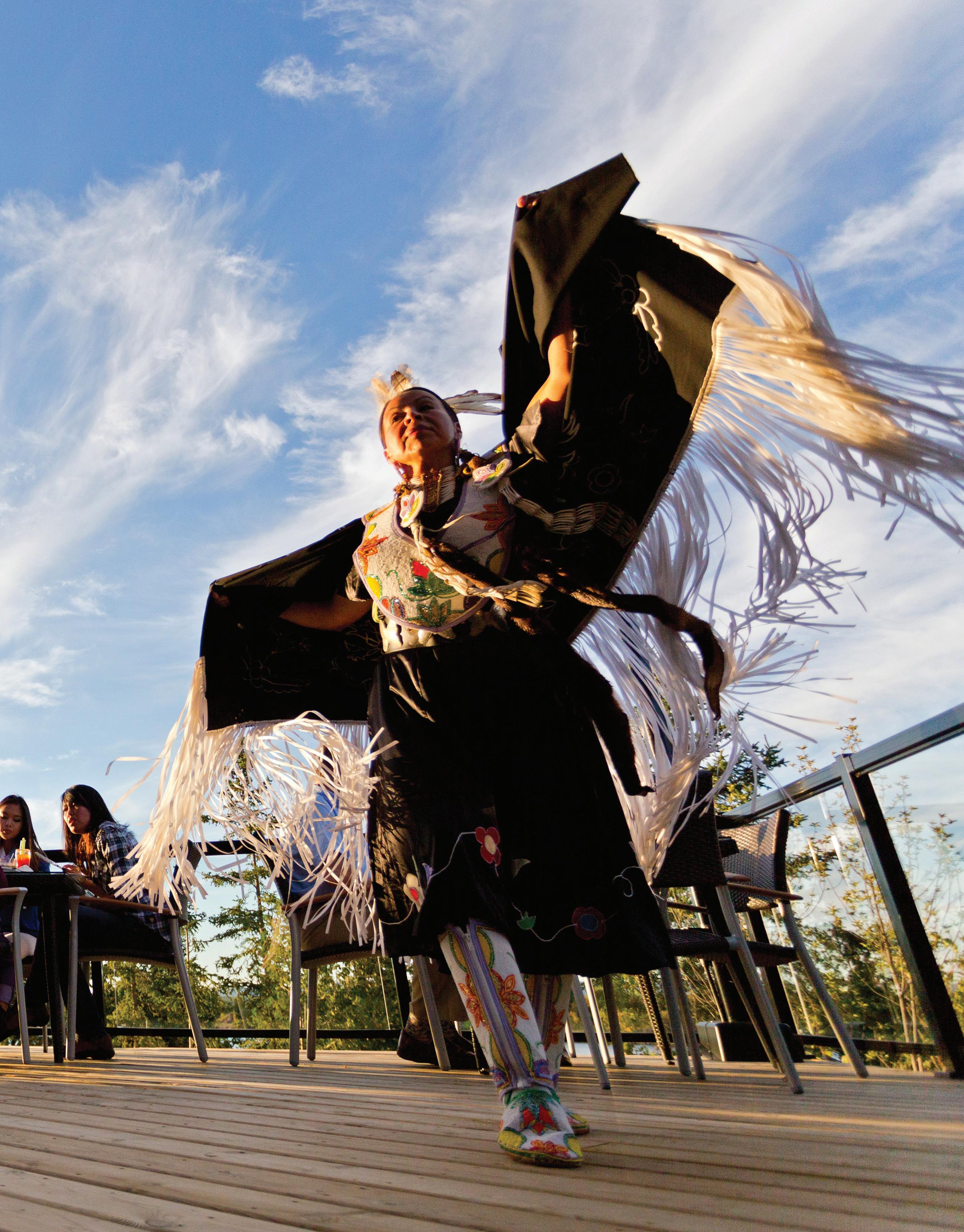
the rise of Indigenous tourism experiences around Georgian Bay, the opportunities to be immersed in exciting cultures are just around the bend.
Kate MacLennanphotography courtesy of Indigenous Tourism Association of Canada and Mark Zelinski Manitoulin Hotel & Conference Centre, Little Current, Manitoulin Island
THE ALLURE OF TRAVEL IS, at its essence, the place where novelty meets curiosity. It’s about stepping away from what you’re used to in order to experience something new and different. Inherent in this, of course, is an element of risk. Will you enjoy it? Will it challenge how or what you think? Will there be ketchup for your fries? Wait, will there even be fries? With such questions packed away, we travel regardless, in search of unfamiliar sights, unusual tastes and smells, foreign customs and cultures, even languages that we can’t understand.
Consider now that you needn’t stray far for that kind of experience; that without leaving the Southern Georgian Bay region you can immerse yourself not only in new sights, tastes, cultures, and languages you are unlikely to recognize, but that even the land you thought you knew like the back of your hand could take on new dimensions. Indigenous tourism is an invitation to do this—to be a local tourist, right here at home.
Unsure? Grab a map that marks the cities, towns, and roads of Grey, Bruce, and Simcoe counties. Ignore the letters and numbers and definitely do not pay attention to county lines or even provincial or national borders. Focus on the rivers and waterfalls that flow in and out of Georgian Bay and Lake Huron, on the myriad lakes, and on the land, which stretches more fluidly in every direction without the congestion of a grid of meridians of longitude and parallels of latitude. There. You’ve probably not left your kitchen table and already you’ve been transported to a whole new place.
Aanii. Boozhoo. Yiheh. Ndio. Hello. Welcome. You have arrived on the traditional territory of the Anishinaabe and Wendat Nations.

Flipping the script is key within the Indigenous tourism experience. Jason Johnston is Interpretive Program Coordinator at Cape Croker Park and sits on the executive board of Indigenous Tourism Association of Canada as Director for Ontario. He shares: “One of the mind-blowing bits in our program—and this is something we’ve done for years—is when you’re on the Bruce Trail we have our boundary markers the government put there that say ‘IR’ on them, which means Indian Reserve. When you cross this line, you are technically outside of Canada. We are our own nation there. It’s not meant to show people ‘here’s a line dividing us’ but to help people think about it. Indigenous tourism is a way for people to connect to their area in a way they never have before.”
In 2019 (the most recent numbers available) more than 2.5 million people visited the Bruce Peninsula for sunsets and beaches, dramatic rock and cliff formations, fresh produce, hiking, fishing, shipwrecks, music, culture and more. Today a sign greets those who arrive at Cape Croker. It says: You are now entering Neyaashiinigmiing, home of the Chippewas of Nawash.
“People come to see the bluffs and water and the trees, and you can go on these trails by yourself, but there’s so much more history there than you’d ever realize. There’s more to it,” says Johnston. “They find out there’s more to this forest—medicines, ceremonial and edible plants that have a part to play in our culture. It’s very sensory. We touch leaves and needles and figure out what things are. Taste is a big focus. We make cedar tea with maple syrup in to
Whether




sweeten it up. And we go to certain spots and simply sit with it. Take it in. So, when you’re hearing our stories you’ve felt the wind, smelled the air, heard the birds. You’ve been there.”
Cape Croker Park is unique in the province for its programming, which is evolving and expanding rapidly. It includes a small cultural interpretive centre, boardwalk and lookout points with covered sitting areas, and a new cultural programs pavilion is in the works. Around four fire pits, the park hosts storytelling nights complete with bannock and tea. Ziibaakdakaan (the Ojibwe word for “sugarbush”) and an awardwinning maple syrup operation is is up and running and open to the public, and after significant delays thanks to the pandemic, this spring the park is expecting delivery of a 29-foot canoe for taking guests out on the water.
“There’s a lot of teachings that go along with the water, and a lot of life in the water, so being able to see things going up the bluff as close to a bird’s eye view as we can get, I’m so excited about that,” says Johnston. “We want people to be welcome, to come, and to learn—that’s what tourism is. I call it a bridge to our culture.”
Pow-wows, he says, are open to everybody and a great place to begin exploring Indigenous tourism. Both Neyaashiinigmiing and Saugeen host one annually, typically a three-day event in mid-August where food, art, music, and dancing at the forefront





of the experience. Dancers and drummers from across Canada who travel what’s known as the pow-wow trail come to perform. Beautiful ceremonial wear, such as the Anishinaabe jingle dress, is elaborate and musical unto itself. Visitors are invited not just to watch but to be part of the experience. Pow-wow is a proud display of Indigenous culture though, interestingly, isn’t a traditional celebration.
“Pow-wows didn’t exist before Europeans [arrived] but were added because a lot of our culture practices, like potlatches, were banned. So, pow-wows became very prevalent, and are an example of how cultures are allowed to change,” explains Johnston. “There’s a big demand for ‘authentic’ Indigenous tourism. I put ‘authentic’ in quotation marks because it’s constantly being redefined by individuals, communities, and businesses to help tourists get past pre-conceived ideas. For a long while the expectation was head dress, loin cloth, bows-and-arrows—and those things have an important part to play in our history, but nobody is running around with those things anymore.”
Sharing all the stories and the facts—the good and the bad— about post-settlement Canada is vital in understanding the history. Indigenous tourism is also a way for a community to address and mitigate any negative biases by showcasing its culture, history, and language without restraint.

“People can get uncomfortable, even angry about what they’re told, because learning can be uncomfortable. My experience with tourism is that I like when people ask questions. Even if it’s aspects I don’t have a ton of experience with, I like to guide them to answer their questions further,” says Johnston. “What’s important to know is that while there’s certainly some overlapping values and teachings across Indigenous cultures across the country, we’re not all the same. If someone goes to a pow-wow and says to an Indigenous person ‘tell me about residential schools,’ well, it’s not up to them to teach that. Tourism is a way for people to learn, but everybody has their own level of comfort about what they want to talk about.

...even the land you thought you knew like the back of your hand could take on new dimensions. Indigenous tourism is an invitation to do this—to be a local tourist, right here at home.

Whereas if you go to a community that has had a residential school and now has shifted to Indigenous tourism, like Tk’emlúps te Secwépemc in Kamloops, they’re ready to share that knowledge and experience from their perspective.”
The bottom line is that with more people than ever open to and curious about Indigenous culture and wanting authentic experiences, relationships between Indigenous and non-Indigenous communities are being bettered because they aren’t built on wrong ideas. The result of such reparation also means more jobs and dollars—for everyone. In 2019 Indigenous tourism contributed almost two billion dollars revenue to Canada’s gross domestic product, and it was the fastest-growing sector in Canadian tourism. Around Southern Georgian Bay, an increasing variety and depth in Indigenous tourism experiences reflect that momentum.
In Owen Sound, tourists on the Walking Together Tour, launched in 2019, visit five locations denoted by eye-catching metal sculptures that are important Indigenous historical locations, including the summer fishing grounds of an ancient Nawash village (in what’s now known as the Brooke area), ancestral burial grounds, and two stops at Kelso Beach Park at Nawash Park. There, Owen Sound city council has also recently approved plans for significant upgrades, including the construction of the Gitche

Namewikwedong Reconciliation Garden. At the historic Owen Sound Farmer’s Market, Chef Zach Keeshig’s pop-up dinner series Naagan has been going strong for more than eight years, featuring a seasonal multi-course menu of Aboriginal cuisine using ingredients that Keeshig forages for—sometimes with guests, during the dinner—or sources locally.
Closer to Collingwood, the current site of Scenic Caves Nature Adventures was once the village of Ekarenniondi, home to the Petun First Nations people. (Before 1616, it’s thought that as many as 8,000 Indigenous people lived in nine villages along the Escarpment.) There, Ekarenniondi Rock one of the most imposing features on the trails; the Wendat people believed it marked the path to the afterlife.
The first primary source of the rock’s story was found in the 1636 writings of Jean Brébeuf, a Jesuit missionary. The Jesuit’s contributions to the widely told European interpretation of Southern Georgian Bay’s Indigenous history has been shared for more than 50 years at Huronia Parks, which includes SainteMarie among the Hurons (with focus on the Wendat people) and Discovery Harbour, closer to Penetanguishine (a Métis perspective).
Candice Moreau, Manager of Marketing and Visitor Services for Huronia Historical Parks, says that the experience at Huronia Parks

















today is very different than the 1970s and 1980s when the focus was more on the archaeology of the site.
“We’ve always tried to tell the Indigenous as well as the European perspective, but as we move into the more modern times of truth and reconciliation, we have migrated our programs to back our mandate to support community relations and community groups, especially our Indigenous partners. We keep building a capacity for this learning. Indigenous Heritage Specialists within our program department are bringing a new perspective, and we are just tipping the iceberg in building those programs.”
The parks have educational programming year-round that focuses on the Indigenous perspective from the historic past. At Sainte-Marie among the Hurons, a long house storytelling experience is part of the Discoveries After Dark evening events, and canoe building and Indigenous artisan craft making part of the Adventures in Time Travel series. On June 21, National Indigenous Peoples Day, the park celebrates Indigenous achievements, artistic talents, and culture with dancers, drummers, and artisans on site to provide the opportunity for storytelling and learning. Instead of closing on September 30 for Truth and Reconciliation Day, it stays open as an educational facility. On that day, says Moreau, “We don’t focus on the historic story that we tell on a daily basis, we focus on building empathy through understanding. We have a sacred fire; Indigenous interpreters speak about truth and reconciliation and relate it to the historic past. A women’s drumming group comes, and it’s a really important way for us to be introspective on the historic site.”
Such change is critical. For a very long time the widely-
shared Indigenous history was Euro-centric—not shared from an Indigenous perspective. Now that how visitors learn and from whom they learn from is shifting, some experiences local tourists may have ticked off their bucket list have a whole new slant—a refreshed element of novelty.
The idea in sharing these stories is not to turn back the clock, but to define a more inclusive future. “To resurrect former times and to relive them would end the fulfilment of visions and growth in the new order,” wrote Basil Johnston, educator, linguist and foremost scholar of Anishinaabe life. Additionally, he is writer and co-author of 22 books who was honoured with numerous awards including the Order of Canada in addition to Honorary Doctorates from several universities. Oh, and Jason Johnston’s grandfather.
Up on Cape Croker, Johnston says, “Many visitors leave telling us that they’d never heard that story, and that they need to know about this. For us, this is what we have left. We want our stories to endure and for people to be respectful of it.”

Curious about Indigenous Tourism? The Original Original is a new brand mark for helping people better identify and book experiences from Indigenous-owned tourism businesses across Canada. The mark identifies that businesses have been vetted by ITAC including four key criteria: the business is at least 51 per cent Indigenous-owned, it’s a business that embraces the values of Indigenous tourism, it offers a market or export-ready experience, and is an ITAC member. destinationindigenous.ca/blog/the-original-original/









In the spring of 1969, two friends headed out on horseback for the adventure of a lifetime.

 by Michelle McMillan
by Michelle McMillan

Helena Kallin and I were 17 in early June of 1969 when we set out from the Beaver Valley on horseback. The mosquitos and black flies had receded, unfurled leaves tinted the treetops soft green and the air resonated with the promise of growth. We had ridden the roads and fencerows of the valley in every season and yearned to venture into new territory. Our Toronto high school challenged us to finish Grade 12 doing something we had always wanted to do but never had. We decided to take a horseback camping trek along the escarpment from Helena’s parents’ farm to Blue Mountain where we would search for the ruins of the Kionontio estate.


After consulting people who were familiar with the area, we plotted a route we could follow and obtained permission from local landowners to camp on their properties with our horses. My boyfriend lent us his car. Any lingering city tension fell away when we drove over the brow of the hill above Kimberley and looked out over the Beaver Valley. Descending into its timeless landscape, we drove along Grey Road 7 to the farm, eager to start our adventure.
On departure day, we woke up to a boundless blue sky and after a hearty breakfast, dashed to the barn to groom and tack up our horses, Comanche and Roger. We secured a tent, sleeping bag rolls, food bags, halters and ropes to the saddles; slung square canvas rucksacks packed with clothing over our shoulders, mounted and ambled down the lane.
Our escapades were chronicled in five acts, one for each day of our journey.
There was no need for conversation as we rode side by side. Fragrance wafted from apple orchards in full bloom as we sat under a maple tree to eat peanut butter sandwiches washed down with water from our canteens. An easy ride up the far side of the valley brought us to the village of Ravenna. In its heyday Ravenna was an essential halfway stop between Owen Sound and Barrie; a bustling place where weary travelers and their horses enjoyed the services of two hotels, stables, a blacksmith, a feed store and a general store. Now reduced to a crossroads on the map by the invention of the automobile, it still had a commercial presence with a general store and gas station for the convenience of modern travelers who stopped but never stayed. Helena photographed me standing beside the gas pumps with the horses before she went in to buy Coke, orange gum, red licorice twisters and cigarette papers.
Back on route, we looked for Baron Casten von Otter’s farm, the home of Toronto’s annual Swedish community Vasaloppet, famous for its grueling cross-country ski race in which Helena was a regular contender. We pitched our tent on the brow of a hill by the farmhouse, dug a pit beside a huge granite rock and built a fire. I took a photo of Helena smiling over her shoulder at me while roasting our potato and wiener dinner. Behind her, the distant grey-blue of Georgian Bay is underlined by a border of grass bending in the evening breeze.
We rode bareback to find a stream for washing up and walked back to our campsite, enjoying the dusky landscape.





“There’s a red sky,” I said. “It’s going to be nice tomorrow.” Helena looked at her watch. “It’s late. Let’s see to the horses and sleep. Oh––we can’t go to sleep yet. We have to watch the Collingwood lights––and the stars.”
Rubble overgrown with wildflowers and grasses filled the spaces between what remained of Kionontio’s stone walls, chimneys and archway so we chose a campsite outside the western wall which still held the warmth of day.
Locally known as Osler Castle, the house was built in 1893 by Britton Bath Osler, a criminal lawyer best known for securing Louis Riel’s conviction of treason during the North-West Rebellion of 1885. Osler built his summer retreat on the 330 acres he owned on the Escarpment in hopes that the fresh breezes and expansive views would ease the suffering of his wife who was wheelchairbound by arthritis. From its high vantage point, one could contemplate the line where sky met water and watch the verdant green of wooded hills turn to the brilliant red, orange and yellow of fall. Mrs. Osler named her new home “Kionontio”, a First Nation’s name meaning “Top of the hill”.
The walls were constructed of rounded granite rocks interspersed with sharp broken stones. The western side was crowned with a line of jagged vertical cap stones that, together with towering stone chimneys and a round turret with a pointed roof, gave the impression of a baronial castle. A hipped gambrel roof extended over a pillared veranda that wrapped around the front and side of the house. At its gable end, facing Nottawasaga Bay, a grand stone entrance arch sat under twin bay windows. Local craftsmen finished the interior with expensive woods, stained glass, fireplaces, an elevator and a wine cellar. Osler stocked his pond with trout and brought in a herd of deer which inspired locals to call the estate “Deer Park”. As winter approached, the Osler’s returned to the city and the house was left to wait out winter.
Sadly, Mrs. Osler died in 1896. Her husband followed
in 1901. The gardener and his wife lived in the house for forty years. After they left, thieves stole everything that could be removed, while vandals trashed the building. The fires of revelers destroyed the rest.
We explored the ruins in twilight, tied Roger and Comanche to the fence for the night, crawled into our tent and declared ourselves, “Queens of The Castle.”
The next morning, we rode single file along The Bruce Trail, appreciating woodland flowers dappled with sunlight. Back on the road, we stopped at a farmhouse to ask for water. Two older ladies welcomed us into their kitchen to sip tea and enjoy banana bread and lemon cream cookies before we, “brave little girls”, went on our way with refilled canteens.
An afternoon exploring Scenic Caves (which cost us $3.00 for admission tickets and $6.75 for drinks and beaded thunderbird headbands made by local indigenous artisans), we rode the rocking horses in the playground, enjoyed the luxury of portable toilets and finished off our perfect day with potato chips and Cokes.
The Blue Mountain chairlifts looked like strings of ornaments floating over the startling green slopes of mowed runs. We found a ready campfire site littered with beer bottles at the crest of the hill, where we set up our tent and cooked a dinner of red chili beans and petit pois. In the last of the candlelight we wrote, “Blue Mountain really is blue!”


Footsteps crunched through the leaves. Something scratched at the tent. The moonlight threw a moving shadow across the wall as big as a bear but we recognized the hunched shape of a racoon. Thankfully, it wandered off and we slept peacefully.
It rained all night. By mid-morning a stream was running through our living room. We sang along with Frank Sinatra’s The Good Life, on the Collingwood radio station, but changed












the lyrics to; “Tripping is the good life, to be free and explore the unknown.”
When we couldn’t take being closed in any longer, we packed our soaked belongings, loaded our horses and tacked cautiously down the hill through the fog. Feeling like time travelers reentering civilization, we rode along the shoulder of Highway 26 to the nearest general store. The proprietress told us we could pitch our tent on her lawn but we were determined to spend our last night at Craigleith Provincial Park. On the way there we stopped at a restaurant beside Georgian Bay for hamburgers, then strolled along the beach and looked for fossils.


“We haven’t had a bath since last Friday,” Helena remarked as she put her hand into the clear blue-green water. Still icy from the spring thaw, it turned her hand bright red—clearly too cold to dip our bodies into. Helena sighed, wiped her hands on her pants and hugged the reassuringly warm body of her horse.
Craigleith Provincial Park was deserted except for a conscientious booth operator who told us that the rule book stated nobody was allowed to walk or ride horses in a Provincial Park. She suggested we try a nearby children’s camp called Arrowhead Ranch. As we approached the ranch, fantasizing about meeting some attractive male camp counsellors, we heard shrieks and squeals from the bushes alongside the road.
“Help, I’m falling off! How do you stop this thing?”
A beautiful boy on a magnificent steed rounded the corner followed by a line of giggling girls on ponies. They looked equally as surprised to see us and we halted to greet each other. His name was Ray. He listened to our issue and suggested we talk with Mr. Campbell, owner of Arrowhead Ranch, who we could find at the black barn with the sign: “Horseback Riding – The World’s Best Sport.” The horses in the barnyard were a motley group: a chubby pony rubbing his bum on the fence, a pinto wandering around with his injured head sewn up and some Arabian horses doing what they do best, looking beautiful. A stable-hand brought out an Arabian stud named Telstar to service an Arabian mare in the
barnyard. We found the successful mating quite invigorating.
Mr. Campbell said he would let us stay the night, offered board and oats for the horses and a cabin for us to sleep in. Feeling like vagabonds, we retreated to a fenced corral to cook our spaghetti and marshmallow dinner over a fire. The campers kept their distance, stared and whispered as they passed on their way to the dining hall.
A voice came from the dark, “That’s not what I call a fire,” and a curly haired guy climbed over the fence, sat down and regaled us with stories of his tractors and fires until Ray came along. The horses had been looked after for the night so Ray drove us to our cabin and helped us get our beds arranged. Then we went to the recreation hall and had fun dancing with the campers. Curly brought water and walked us to bed by sparkler light.
We woke early, packed our things, swept out the cabin and joined the campers for breakfast. Mr. Campbell charged us $3.00 each, for his much-appreciated hospitality. After taking photographs we said goodbye, promised we’d come back to visit someday and started for home.
At Heathcote General Store we bought a package of Danish pastries and sat outside to savour every one of them. The horses knew we were close to home and quickened their pace and we soon found ourselves galloping up the laneway with no one to greet us but the excited border collie Sam. We were happy to be home, “loaded with experience and no regrets.”
After a shower, a long hot sauna, dinner and a contented night’s sleep, we wrote the last entries in our journal before driving back to Toronto, beginning with; All the while, we faced piles and piles of miles with smiles…
A special thanks to Roger and Comanche for being so patient. Thanks to our families for their support and letting us trustworthy chicks try the tripping bit.
Mission Accomplished.


 Waterfront dining in the heart of Georgian Bay
Waterfront dining in the heart of Georgian Bay



The one thing that remains unchanged is its location—a stone’s throw from golfing, skiing, and the world’s longest freshwater beach.
by Cara Williams photography by Clay DolanIIN SEPTEMBER 1913 A YOUNG PILOT was reportedly paid $25 to fly over the Great Northern Exhibition fairgrounds near Collingwood. The publicity stunt made headlines and attracted record crowds. After touching down a half mile away, the enterprising pilot offered plane rides for $1, much to the chagrin of the midway operators whose attractions sat idle while fairgoers flocked to marvel at the flying machine. This was arguably the first known aircraft to land in the grassy fields that would later be home to Collingwood’s regional airport.
For over a hundred years, the port of Collingwood has acted as not only an important point of access for railways and marine traffic, but has also had a significant impact on the country’s aviation history. At the beginning of World War II, Clyde Aircraft Manufacturing took over a factory previously occupied by Imperial Wire and Steel in Collingwood (the site that would later become home to Kaufman Furniture). Parts manufactured here were then sent to Europe, with the majority made specifically for the Canadian-built Mosquito Bomber aircraft.
In a seemingly political move to curb spending, Prime Minister John Diefenbaker famously and suddenly terminated
the controversial Avro Arrow Project in 1959. The Arrow was an interceptor jet intended to engage and destroy the long-range nuclear bombers being developed after WWII. It was Canada’s first supersonic aircraft, and is considered by many to have been one of the most highly advanced technological achievements by the Canadian aviation industry. February 20th, 1959 was dubbed “Black Friday”, as everything related to the Arrow was ordered to be destroyed and/or scrapped. The Martin-Baker Aircraft Company had a licensed facility in Collingwood during the 1950s and built assembled ejection seats for the twinjet interceptor/ fighter, the Avro Canada CF-100 Canuck. Conflicting accounts hold that ejection seats constructed here may also have been made for the legendary Arrows. To this day the actual reason for the cancellation of the Project remains an urban aviation myth.
It was 1966 when the Canadian federal department of transportation officially approved the site for Collingwood’s airport. Located 8km south of town, in the former Township of Nottawasaga (now Clearview Township), the Town of Collingwood purchased the property for $67,749. The original “soft field” grass runway was built in 1967 and by 1970





Collingwood began providing aviation services and facilities under the Transport Canada identifier CNY3. In 1974 the runway was rebuilt and paved with federal funding assistance, and by the early 1980s the Town invested $74,993 to purchase an additional parcel of land. By the end of that decade a small public apron was constructed alongside the 3,000 ft runway, including a public terminal facility with a restaurant where hungry pilots and travelers could grab a quick bite. Jimmy’s Kitchen (as it is known today) is a favourite among local aviation enthusiasts— the Collingwood Flying Club regularly attends their Thursday lunches to exchange flying stories over a hot meal. In 2009 the runway was extended enabling larger aircraft to land and ten years later, in 2019 the airport was sold by the Town of Collingwood to Winterland Airfield Holdings. Under the new ownership the airport has seen significant enhancements, ushering in a new era of aviation.

“Over the last four years Winterland has made huge capital improvements that have attracted businesses and corporate aircraft operators to the airport,” says Brendan Skidmore, Field Boss, Collingwood Airport. “There has been an increase in traffic from the corporate sector, improving the balance sheet and providing jobs and revenue for the region. Levaero Aviation Group and Big Blue Air are our biggest partners. You should see the flying done by Big Blue’s helicopters. I would encourage everyone to take a ride with them and see the Escarpment

‘“When once you have tasted flight, you will forever walk the earth with your eyes turned skyward, for there you have been, and there you will always long to return.”
– LEONARDO DAVINCICollingwood Regional Airport, circa 2019










from the air—it’s magic! Levaero is also an amazing business. They support and represent Pilatus Aircraft out of Switzerland and they are a class of their own. Our Airport is attractive to them because we provide great service and new facilities at a competitive price, plus you can’t beat our location as a place to work, live and fly!”
Levaero Aviation officially landed at the Collingwood Airport in April 2022. Based in Thunder Bay, Levaero has a national sales office in Toronto but has had a presence in the Collingwood area with charitable ties to Special Olympics and the 24-Hours of Blue Mountain, which raises funds for the Collingwood General & Marine Hospital Foundation. Levaero’s new 18,000-square-foot hangar provides support to Pilatus aircraft owners, as well as other turboprop and jet operators in need of a maintenance provider. The company also assists customers in acquiring and selling aircraft.

“Our new facility at the Collingwood Airport is the latest in our expansion plans to support our growing customer base,” says Stan Kuliavas, Levaero Aviation Vice President Sales. “As the first major OEM authorized dealer and IADA accredited broker located at the airport, we look forward to serving our existing customers in the region, as well as assisting others with their aviation needs. It’s a friendly place to be, and strategically, it’s a great spot—close to Toronto, but far enough away that you don’t have to deal with

“Over the last four years
Winterland has made huge capital improvements that have attracted businesses and corporate aircraft operators to the airport.”
— BRENDAN SKIDMORE, FIELD BOSS, COLLINGWOOD AIRPORT.Genesis Flight College’s state-of-the-art flight simulator





some of the challenges that come with being right in the city.”
Big Blue Air has been based in Collingwood since 2015 offering sightseeing tours and aerial photography—their highly skilled pilots are known for positioning the aircraft in order to achieve the perfect midair shot. With two helicopters and one fixed wing Pilatus airplane, their service menu also includes VIP and corporate travel, as well as experiences such as “Fly & Dine” trips to Georgian Hills Vineyard and Cobble Beach. Owner Marcus Vogel says the aviation industry has experienced healthy growth, spurred on by the end of Covid-19 restrictions. “Customs is back at the Collingwood Airport,” says Marcus. “During midweek business hours, flights are landing here from New York City, Boston, Naples, Miami, Chicago, Europe and South America. As long as aviation stays strong there is a ton of potential for future developments in Collingwood. As the town continues to grow in tourism, so do we.”

Brendan Skidmore agrees; “I have been working here for several years and it’s been a whirlwind of growth and change. There is a new young team in place—all of us under the age of 35—managing operations and servicing customers. The energy and professionalism they bring to the airport is amazing. Our goal is to be a pilot’s airport, so we service everyone from the pilot
who flies a home-built aircraft right on up to the RCAF’s giant Hercules. We have planes coming from all over the world now that we have the proper facilities. It’s fabulous to see a $60 million private jet fly in from Europe or South America. It can get pretty crazy in our airspace, especially when you add in a plane or two from Genesis Flight College.”
If you’ve ever been curious about flying, Genesis Flight College makes earning a commercial or private pilot’s license a reality, with some of the most advanced training equipment in Southern Ontario. Under the supervision of a qualified flight instructor, Genesis lets students take control of the aircraft, learning basic maneuvers like how to turn, climb, descend, and control speed. And because Collingwood is a regional airport, student pilots don’t have lengthy air traffic control delays or long waiting times to take off or reach the practice area. The leisurely nature of the Collingwood Airport also provides a more relaxed training atmosphere.
“Airports are capital intensive and tricky to operate,” notes Brendan. “There are many moving parts and it’s important to attract the right businesses. We have had a great relationship with Clearview Township and they recognize what a great asset we are to the community. We intend to grow and serve our region, and we look forward to some exciting projects in the near future.”






 *Renderings are artist’s concept. E&OE.
A private collection of four-season modern towns, bungalows and singles.
*Renderings are artist’s concept. E&OE.
A private collection of four-season modern towns, bungalows and singles.




Restaurant in Thornbury is inspired by family—at first glance the historic building at 15 Harbour Street (formerly a CCM skate factory) reminded Tyler Hickling of his grandfather’s printing press, Sterlings Lithographers. “As soon as we saw the old red brick and the industrial character of the building it felt like home,” says Tyler, General Manager. “Some of my fondest memories of growing up was visiting Sterlings. Later we would sit around the dinner table and share stories from the day. My parents and grandparents instilled the value and importance of family gatherings. Paying homage to the past and celebrating kin is at the core of everything we do here.”
Situated in the heart of the Blue Mountains, with indoor/outdoor waterfront dining, Sterlings Restaurant has a casual Mediterranean dining vibe and features a boutique marketplace with curated goods and locally sourced products. Menu items are inspired by friends, employees and those who have helped pave the way for Sterlings, including Co-Manager, Tierney Hill. Serving home-cooked meals made with only the freshest ingredients, Sterlings is delighted to share three spring inspired recipes with Escarpment readers.

SERVES 4 - 6
“Risotto is one of my favourite dishes to cook for my family,” says Tierney. “I love opening a bottle of wine and immersing myself in the food I’m preparing. After a visit to the Spanish island of LA Palma, we fell in love with Spanish variations of the traditional meals.”
4 cups seafood broth
1 tbsp olive oil
2 tbsp butter
1 Spanish onion, diced
3 cloves of garlic, minced
2 cup Arborio rice
1/2 cup dry white wine
(suggested: Macabeo)
1 roma tomato, diced
1 tsp salt
1/2 tsp pepper
1/4 tsp cayenne
1/4 cup parsley, finely chopped
1/4 cup Manchego cheese, grated
1/4 cup scallops
8 jumbo shrimp *or substitute
mussels, lobster, clams
2 tbsp butter
1/2 tsp salt
1/2 tsp pepper
2 tsp paprika
METHOD
Bring seafood broth to a boil, and then simmer. In a separate pan, heat olive oil and butter. Add diced Spanish onion and cook until browned and translucent. Add minced garlic. Add Arborio rice and cook until toasted. Once toasted, add your favourite Spanish dry wine and simmer until absorbed. Once absorbed, add diced roma tomatoes. Cook for 3-4 minutes. Season with salt, pepper and cayenne; stir to incorporate. Add seafood broth, ½ cup at a time, allowing broth to absorb before adding more. Once all liquid is absorbed and rice is cooked, add parsley and Manchego. Heat butter in a pan. Season seafood with salt, pepper, and paprika. Add shrimp to butter and cook until bright pink. Add scallops and cook until tender. Stir butter and seafood mixture into Risotto pan. Plate and serve.

SERVES 2 - 4
“From the age of two my daughter Millo has loved duck,” says Tierney. “She loves to weigh in on menu ideas and inspiration— usually accompanied by a thumbs up, thumbs down, or a ‘so-so’ gesture. This dish officially received a thumbs up!”

4 duck confit legs, pulled
1 tbsp green peppercorns, crushed
1/2 shallot, diced
1 tbsp grainy mustard






1 tbsp hoisin sauce
1/2 cup panko
4 egg yolks, whisked
Salt and pepper to taste
1/4 cup Manchego, shaved
6 tbsp mayonnaise
2 tbsp hoisin
2 tbsp lemon juice
Croquette: Mix duck confit, green peppercorns, shallots, grainy mustard, and hoisin in a bowl until fully incorporated. Season with salt and pepper. Form into balls about 2” in diameter. Should make 12 croquettes. Place in freezer. Whisk 4 eggs in a bowl. Once the croquettes are frozen, coat each in egg wash and then fully coat in panko. Heat a pan with enough oil to half cover the croquettes in the oven until it reaches 350°F (or use an air fryer). Fry coated duck, rotating to cook each side, for 10 minutes or until an internal temperature of 125°F.
Aioli: Mix mayo, hoisin, and lemon juice. Put three spoonsful of aioli on an appetizer plate, place croquette (recommended 3/person) on top, and garnish with Manchego.
SERVES 4
“I am a big fan of food that is inspired by fond memories,” says Tyler. “As a child I loved going to the local ice cream parlour and ordering a banana split. Traditionally this dessert is simple yet fun and with a twist it can be transformed into an elegant treat.”
Chocolate delice
453g dark chocolate, melted
6 egg whites
80g unsalted butter
13g flour
13g sugar
8g sea salt
METHOD
Melt Dark Chocolate in a metal bowl,
over boiling water. Mix egg whites, butter, and sugar in a stand mixer until light in consistency. Add melted chocolate to egg white mixture until combined. Add flour and salt. Pulse until fully incorporated. Line a small dish with baking paper (I like to use different shaped muffin tins, fill ¼ to half way for circular shape). Bake at 110°F for 16 minutes. Cool in fridge for up to 24 hours. When ready to plate cut to the size of your liking or use a cookie cutter of choosing.
White Chocolate Mousse
267 ml cream
2 egg whites
200g white chocolate
METHOD
Melt white chocolate in a metal bowl, over boiling water. Mix 2 egg whites in stand mixer and whisk until fluffy. Pour in melted white chocolate to the egg whites and mix to a smooth cream, or until light peaks form.
Milk Chocolate Sauce
100g milk chocolate
200 ml cream
1/2 tsp cocoa powder
METHOD
Melt milk chocolate in a metal bowl, over boiling water. Bring 200 ml of cream to a boil and add 1/2 teaspoon of cocoa powder. Whisk in melted milk chocolate. Put into a container to pour over your dish once plated, serve warm.
Bananas Brûlée
4 bananas
3 tbsp sugar
Cut each banana into smaller pieces, recommended size like a marshmallow. Roll or sprinkle each piece of banana in sugar. For added flare, pour drops of brandy and using a torch watch the blue flame dance along the banana. Lay down or stand up bananas covered in sugar and use a torch to crystalize the sugar. Keep moving the torch back and forth or up and

























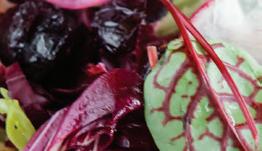



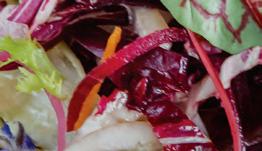

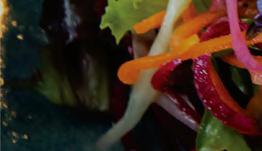













down. If it starts to blacken pull the torch away. If you don’t have a torch, use a clean non-stick pan and medium heat and move bananas around to caramelize evenly.
PLATING METHOD
Begin with 1-2 pieces of Chocolate Delice. Place 1-2 dollops of white chocolate mousse on the plate, on top of the chocolate delice. Place bananas brûlée on top of the chocolate mousse, or on the chocolate delice. Place a tablespoon of crushed oreo crumb on the plate, creating a bed for the vanilla ice cream. Place vanilla ice cream on top of cookie crumb. Add personality to the dish; crushed peanuts, crushed cashew, chocolate bark pieces, fresh berries. Pour warm chocolate sauce on the plate to finish.

SERVES 2
“Each day we offer a Chef’s Salad feature at Sterlings,” says Tyler. “In spring our focus is on fresh and seasonal produce—plant based, raw foods, gluten free, pescatarian and vegan options. It is a priority for our culinary team to offer all those in our community an incredible dining experience without fuss.”
4 cups of arugula (we prefer Sideroad Farms when available)
20 cherry tomatoes, halved
1 cucumber, diced
1 pomegranate, seeded
4 ahi tuna steaks (available in Sterlings
Boutique Marketplace)
4 cups of cooked quinoa (recommend
cooking in a seafood broth to add flavour)
1/2 cup rice wine vinegar
2 cloves garlic, minced
1/3 cup honey
2 tbsp soy sauce
2 tbsp wasabi paste
1 tbsp sesame oil
1 tbsp fresh lime juice
Whisk rice wine vinegar, garlic, honey, soy sauce, wasabi paste, sesame oil and lime juice until combined. Season with salt as desired, although not too much as the soy sauce adds a salty element.
1 cup of arugula/plate as a base. Top with 1 cup of quinoa/plate. Pour one ounce of dressing over quinoa and arugula. Divide cherry tomatoes and cucumbers amongst the plate. Cut the ahi tuna steak into small cubes and place across the ingredients on the plate. Sprinkle pomegranate seeds. Pour another ounce of wasabi dressing across the tuna. Sprinkle with salt—our particular favourite is a rose hibiscus infused salt found in the Sterlings Boutique Marketplace.








If you’re wondering what the naturopathic remedy is for headaches— there isn’t one. This is because a headache is a symptom and what may be causing it could be different for each person. One thing is for certain though, it’s not an ibuprofen deficiency. So, let’s look at some of the most common causes and solutions to consider. *
STRUCTURAL This could be pertaining to an injury, muscle tension, posture, jaw clenching, sleeping position, pinched nerve, etc. We are fortunate in this region to have a variety of great physical therapy practitioners who can explore how your structure may be contributing to your headaches, such as chiropractors, osteopaths, physiotherapists, massage therapists and pilates teachers. If muscle tension is determined to be a contributing factor, a deficiency of magnesium or inadequate hydration may be worsening your symptoms.
FOOD SENSITIVITIES Once your food has been eaten, digested and absorbed it
is then presented to your immune system. If your immune system reacts to any of the compounds it will trigger inflammation, which can present in your body in many ways such as headaches, joint pains, skin issues, frequent illness, difficulty losing weight, and more. A blood test (IgG Food Sensitivities) can help identify these triggering foods.
HYDRATION You have probably experienced this yourself—your hydration level can impact the severity and frequency of headaches. Be sure to consume at least half your body weight (lb) in ounces of water and herbal teas each day and add electrolytes to your water on hot days and during workouts.
HORMONES If you notice a cyclical pattern to your headaches through the month, or if you are in your 40s or 50s, and have ovaries, you may be experiencing hormonally related symptoms.
Tracking these and discussing them with your naturopathic doctor (ND) will help determine next steps, which may include hormone testing.
Dr. Shelby Worts, BSc, ND
ENVIRONMENTAL CHEMICALS in your environment may be triggering your symptoms. Common culprits are fragrances, off-gassing of new building materials or furniture, hobbies (if solvents are involved), etc. Allergies can also create headaches. This can be made worse if you are experiencing digestive issues such as constipation.
STRESS How you hold and deal with stressors can have a physical impact on your body, from hormone production to muscle tension and sleep quality. I discuss stressors with every client as I find they can impact health profoundly—often in ways not commonly considered.
While exploring the cause of your headaches it’s important to also have pain-relief solutions. For these I refer to TCM acupuncturists, MDs who can prescribe medical cannabis, or recommend intravenous (IV) nutrient therapy. NDs love IV therapy for reducing the frequency and intensity of headaches, and have actually seen some acute migraines resolve during a 20-minute infusion.
Most headaches have a solution—work with your ND to explore what is getting in your way of you being pain-free. A full work-up may include comprehensive blood work, to explore nutrient deficiencies, inflammation, hormones, or food sensitivities. Don’t suffer in silence— there is help out there for you!
*These are general suggestions and should not be interpreted as medical advice. Discuss this with your qualified healthcare practitioner, especially if you are pregnant, taking medications or dealing with a chronic disease.
What can you expect with our care?







• Wonderful caregivers with a passion for caring
• Your own Care Team - the same Care Providers, consistent and committed to caring for you






• Your Care Planner available for you anytime
• Commitment to Communication, so everyone is “in the loop”


Companionship
Homemaking and Healthy Meal Preparation
Shopping, Errands and Transportation
Hygiene and Personal Care
Physical Assistance
Virtual Healthcare System Navigation

Nursing and Therapy
Dementia Specialists
Hospital-to-Home Transition and
Adding life to years. It’s what we do.
“My Dad’s doctor asked if we were happy with Right at Home. I told him we were ecstatic with your service, professionalism, communication, and how caring your team is. My Dad said ‘I just love them, I’m very happy with Trisha and everyone I meet.’ Dad’s overall demeanor has really improved and perked up since we started with Right at Home. You make such a good impression on him, despite his dementia. Thanks again for the great job you all do for families and the peace of mind you give me and my sisters.”



Pia M., Collingwood
I’m your local Right at Home Care Planner.
I am so glad you found us.
Adrienne Wood, Care Planner, Georgian-Triangle 705-293-5500 | 1-855-983-4663 awood@rightathomecanada.com








Now is the perfect time to indulge in an aesthetic treatment or medical grade product that leaves your complexion rejuvenated & fresh!
COSMETIC INJECTABLES
MEDICAL GRADE FACIAL TREATMENTS
HYDRAFACIALS
BODY CONTOURING
SKIN REMODELLING
For a deep cleaning treatment that leaves your skin radiant, HydraFacials are always at the top of our list. See and feel the difference after just one treatment!

LASER HAIR REMOVAL
WEIGHT LOSS & HEALTHY LIVING MANAGEMENT
PRP PLASMA TREATMENT
SPRAY TANNING
IPL TREATMENT
Vitamin C is the 'lighten, brighten, tighten' product of skincare, and a step in our skincare regimen that we personally never skip!

Allowing herself to be guided through open curiosity, awe and reverence, Bonnie Dorgelo places trust in the fluid movement of colour energy via acrylics, inks and water on canvas to create paintings that connect between inner nature and nature’s sacred wonders.
by Deena Dolan photographyby Clay Dolan

YEARS AGO, WHILE VISITING her then gallery in downtown Collingwood, I enjoyed a delightful gift of time chatting with artist, Bonnie Dorgelo. Long a fan of her work, speaking with her in person formed a firm and lasting impression—both personally and artistically. Captured always by Bonnie’s ability to manipulate colour while creating movement, that brief conversation altered my perspective of how I viewed and interpreted her work. I was struck anew with how her canvases sang, infused with her lyrical sense of joy.
Meeting with her recently, enhanced my impression. The woman is an inspiration. And—she has no idea. There is no guile. The spirituality evident within Bonnie Dorgelo is unmistakable. It’s palpable. Of this, Bonnie is completely aware. It’s who she is, she exudes it. As a member of the human race, she embraces it, while as an artist, she infuses it onto and into her canvases. You can’t miss it.
“If you ever get a chance to watch ‘Where the Universe Sings’ about Lawren Harris, I highly recommend it,” smiles









Bonnie. “I love how he expressed a strong spiritual essence within his Canadian landscapes and spent a great deal of time outdoors.” Indeed, for Bonnie, spending time outdoors is an understatement. As a child, the oldest of five siblings, Bonnie spent most of her waking hours exploring nature whenever possible. Her need to be one with it only grew as she grew. Eventually, in 1992, her adventures with her siblings took several of them to Whistler, British Columbia. In her 20s at the time, the adventures became
bigger, bolder, riskier; skiing; mountain biking; mountaineering; hiking; rock climbing; and wilderness survival. From there, the world beckoned and she travelled—Malaysia, Thailand, Australia. “There were always bodies of water nearby. I remember having to be pulled off the coral reefs.” For years, Bonnie explored, collected experiences and held onto various found-objects of interest, not knowing that one day, these very things would somehow contribute to her emergence as a visual artist.

...a seasonal art gallery, showcases an eclectic collection of Paintings, Fine Art Photography and Pottery from local artists and American artists.”



Open from June to October Michael Cannon 519.797.2052 101 Grosvenor St. S., Southampton @Studio101Gallery







Upon returning to Collingwood, Bonnie happened to connect with the late Carol Whyne who had founded the Georgian Bay School of the Arts. She enrolled in a five-day abstract acrylic course. “I was hooked and wanted to do more.” At Carol’s suggestion, in 2002, Bonnie enrolled in the Haliburton School of Art. Something clicked. “It was one of those magical moments, when you come together with land, water, air, trees— the right people at the right time. I felt like it was home.” It was a brief period—15 weeks—but Bonnie was ensnared. She wholeheartedly jumped into the local art scene, not as a painter but as a creator of wire sculptures. Her pieces became known, she won awards and using small steps, she intuitively worked her way up into the larger world of art. From there, she moved into jewellery design and her success was so immediate, it became her major focus. By necessity, painting took a back seat. Then, in 2012, Bonnie opened her own boutique art gallery in Collingwood. Bonnie’s partner, Nic Gallo took on the role of managing the gallery thus allowing Bonnie time to pursue her passion for

painting once again. The bright location provided an ideal space to showcase her intricate, silver jewellery and her large-scale, colour-inspired canvases.
But then, in a flash, it all came to a screeching halt. Literally. On January 21, 2014, a horrendous car accident changed everything. Everything that is except for the spiritual essence of the artist herself. Broken bones could, and would, delay things but nothing could quell the indomitable creative energy of Bonnie Dorgelo.
Before the accident Bonnie had been on a bit of a treadmill, having nearly reached the ceiling of what she could possibly produce as just one person. The accident, as dreadful as it all was, forced her to pump the brakes (pun intended). There was no other choice but to regroup, prioritize and take stock. It was an arduous period. Pain, fear, panic and anxiety were constant companions but a combination of physical rehab and emotional therapy worked in concert with Bonnie’s strong work ethic and propelled her forward. Following her own creative guidance, she


‘Each blank canvas is a journey of discovery…a search of knowledge, inspiration and spiritual revelation’. ~ Jane Ash PoitrasWhere Edges Meet, acrylic & ink, 20" x 16"
embarked on a strict regimen of journaling. She felt that to be worthy, she had to create—the countless projects she produced during that time are fascinating.
Dorgelo’s progression of healing is abundantly evident today. She has learned to give herself permission to be more open and patient. “To be in creative flow, it’s best not to overthink. For a creative experience to feel more successful, resistance dissolves as I allow myself to be guided with open curiosity, awe and reverence. Am I paying attention? Am I listening? Am I trusting?”
A huge new body of work sits alongside her previous pieces. “Right now is an interesting time,” states Bonnie. “I feel like I‘m in transition. I am more connected on a spiritual level.” Bonnie


has an uncanny sense about where she’s at in this moment. “My work has improved but I feel that my art therapy work and the other work that I have been doing are coming together to produce something new. I’m right on the edge of it.” The works of outspoken and fearless artist Jane Ash Poitras, as well as the mystical renderings of Swedish artist Hilma af Klint, have made an impression on Bonnie and may play a role of influence in yetto-be-produced works.
Bonnie’s use of colour is otherworldly. “Colour can be a portal that activates access to that sacred part of ourselves. It opens us to the aliveness within, moves us, nourishes, comforts and inspires us.” Working on the floor using gravity, Bonnie



begins a project with a “loose intention” of a theme—waterscape, airscape—and using her hands, follows where the colour wants to go or where the horizon line wants to rest. She works fluidly in layers, encouraging an interplay between the acrylics, inks and colours. “Through trusting the fluid movement of colour energy via acrylics, inks and water while deepening the connection between inner nature and nature’s sacred wonders in our outer world, true magic happens.”

Bodies of water and harmonious hues of blue play a strong role in Bonnie’s work. “There’s something about water that is so resonant to us. When in close proximity to water—whether it’s gazing upon it or diving into its embrace—I immediately feel a calming, healing, cleansing effect, simultaneously soothing and invigorating my nervous system, heart and soul.”
Working once again in her gallery on Blue Mountain Road, Bonnie is open by appointment but keep an eye out for pop-up shows and seasonal hours. Bonnie’s work is also available at the Loft Gallery in Thornbury. She accepts commissions and loves the challenge of creating luminous colour environments that hold meaning for her clients. “I reverently create from a place of how our sacred waters and the air we breathe ‘feels’.” Her passion is unmistakable. “Art changes lives. It’s a dance with the divine. It connects us with our higher, inner guidance system. If we can be present to this deeper connection, that precarious line between inner and outer realities becomes harmonized.”







design tips to landscaping inspiration, the Backyard Glam Tour showcases six stunning, professionally staged backyards throughout the Town of the Blue Mountains.
 by Cara Williams and Deborah Lalande
by Cara Williams and Deborah Lalande
OBJECTIVE – Ask yourself how you plan on using your outdoor space. The most common answers include entertainment, exercise, gardening, relaxation, or creating a play area for the kids. But don’t forget about privacy, and how the needs of your family may evolve over time. Whether your design is big or small, considering how you intend to use the space is the most important step.
STYLE – An effective landscaping plan is one that entices the homeowner outside by making the outdoors feel like an extension of the house. Creating a tie or sense of continuity between your house and yard is the best way to capitalize on your outdoor area and will help to build on the architectural integrity of your house.

MAINTENANCE - Consider how much time you want to spend maintaining your outdoor space—this will be important when selecting appropriate plants and materials. Keep in mind the Escarpment’s four-season weather and natural landscape when making selections and choose items that will match your maintenance intentions in the long run.
BUDGET - Regardless of how much you expect to spend on your project, working with what you already have can save both time and money. That doesn’t mean you have to keep everything, but it may serve as a good starting point in creating your ideal outdoor living space.
The 2022 Backyard Glam Tour visited six magnificent backyards, all professionally designed and landscaped by local businesses and trades. Whether you’re seeking something as simple as a covered porch or a more complex build such as an outdoor kitchen, entertainment/ lounging areas and a pool, inspiration is right around the corner—Deborah Lalande, Backyard Glam Tour Chair, takes us on a tour of six stunning backyards.
Outdoor living spaces are an extension of our homes. In a few short months, our backyards will once again be a favourite place to entertain, unwind and enjoy the longer days and nights. Whether you’re looking to enhance or completely remodel, there are some important factors you need to consider before embarking on backyard design.
PREVIOUS SPREAD
Traditional outdoor Canadian colours work very well for this home—the burst of red accessories in contrast to the slate grey façade of the home add dimension and cohesiveness. The kidney shaped pool is the focal point of the space and several umbrellas and a retractable awning offer respite from the sun.
The owners of this sunny backyard oasis are well traveled and souvenirs in the form of art sculptures adorn their yard. They love to entertain and have several areas for friends and family to gather. A covered dining area and a covered fireplace conversation area provides places to gather intimately. Many backyards are “open concept living” and this one has it all. The pool area with sun tanning loungers and a large conversation area make this backyard a welcome retreat or a great gathering place to entertain. To tie this backyard together, items such as an area rug, umbrellas, cushions and accessories give the space a cohesive look.





Being on the water has its challenges. The best choice for exposed landscaping is heavy, low maintenance furniture made of metal, like aluminum or wrought iron. Several groupings were built around the expansive yard and the homeowners make use of every space. Dining and entertaining are protected back from the water but still offer a stunning view. Colourful umbrellas and accessories pulled this coastal beauty together.










This home backs onto a golf course, the backdrop of the manicured lawns and forested areas are picture perfect. The homeowners love to garden and enjoy colourful flowering plants so the art that was displayed in the backyard reflected this. Art can be used to bring a space together as do other accessories such as an outdoor rug. They will also provide the space with a feeling of bringing the indoors out. The swimming pool with loungers, the cozy covered seating area with fireplace and the outdoor kitchen with dining complete this backyard.
Tying this space together was done by the use of furniture groupings in the same family but in different areas of the backyard. A neutral cool colour scheme with a pop of bright orange combined with textured fabrics provides a nice contrast to all the nature in the backyard.
The homeowners love to entertain but also enjoy having morning coffee by the pond so a two-person setting was important. This sanctuary backyard can hold a very large event with the different groupings but also feel cozy when needed.










This backyard and property take your breath away—literally. The wind proved to be a challenge so the homeowners invested in heavy furniture and good quality umbrellas with weighted bases. Even the accessories needed to be significant. Matching the façade of the home, a neutral colour scheme echoes the classic architecture and the Sunbrella fabric on the cushions make them easy to maintain. The weight and endurance of the poly-resin furniture means that it can be left outside and is not going anywhere.

“This year, the featured backyards are a combination of small town and waterfront living, all offering different outdoor perspectives,” says Deborah Lalande, Chair, Backyard Glam Tour. “We are proud to showcase a mix of properties, from smaller areas that utilize space and function, to luxurious and lavish outdoor living areas.”
Additionally, the Backyard Glam Tour will feature “glamourous vehicles”, an art crawl, silent auction to benefit the Beaver Valley Outreach (BVO), outdoor living seminars as well as a chance to win some fantastic gifts and or services courtesy of local retailers and participants. Tickets are $35.00 each (HST included) and are available online at designoutdoorscanada.com or at Design Outdoors Canada located at 13 Louisa Street East in downtown Thornbury. $5.00 from each ticket sold will go directly to the Beaver Valley Outreach.
Backyard landscapes should be functional spaces that are both useful and beautiful— don’t miss the 2023 Backyard Glam Tour. Visit designoutdoorscanada.com for more information and tickets.

FRIDAY, AUGUST 11TH, 2023
11AM-8PM Map and tour bag pickup Tour the silent auction located at the Design Outdoors Canada
6-8PM Art crawl, Downtown Thornbury NEW
8-10PM Night Tour
SATURDAY, AUGUST 12TH, 2023
8:00AM Map and tour bag pickup
8:30AM breakfast at Design Outdoors Canada
9AM-10AM Breakfast seminars and door prizes
10AM-4PM Tour the backyards with glamorous vehicles NEW
3PM Silent auction closes
4PM Draw for outdoor design consultation









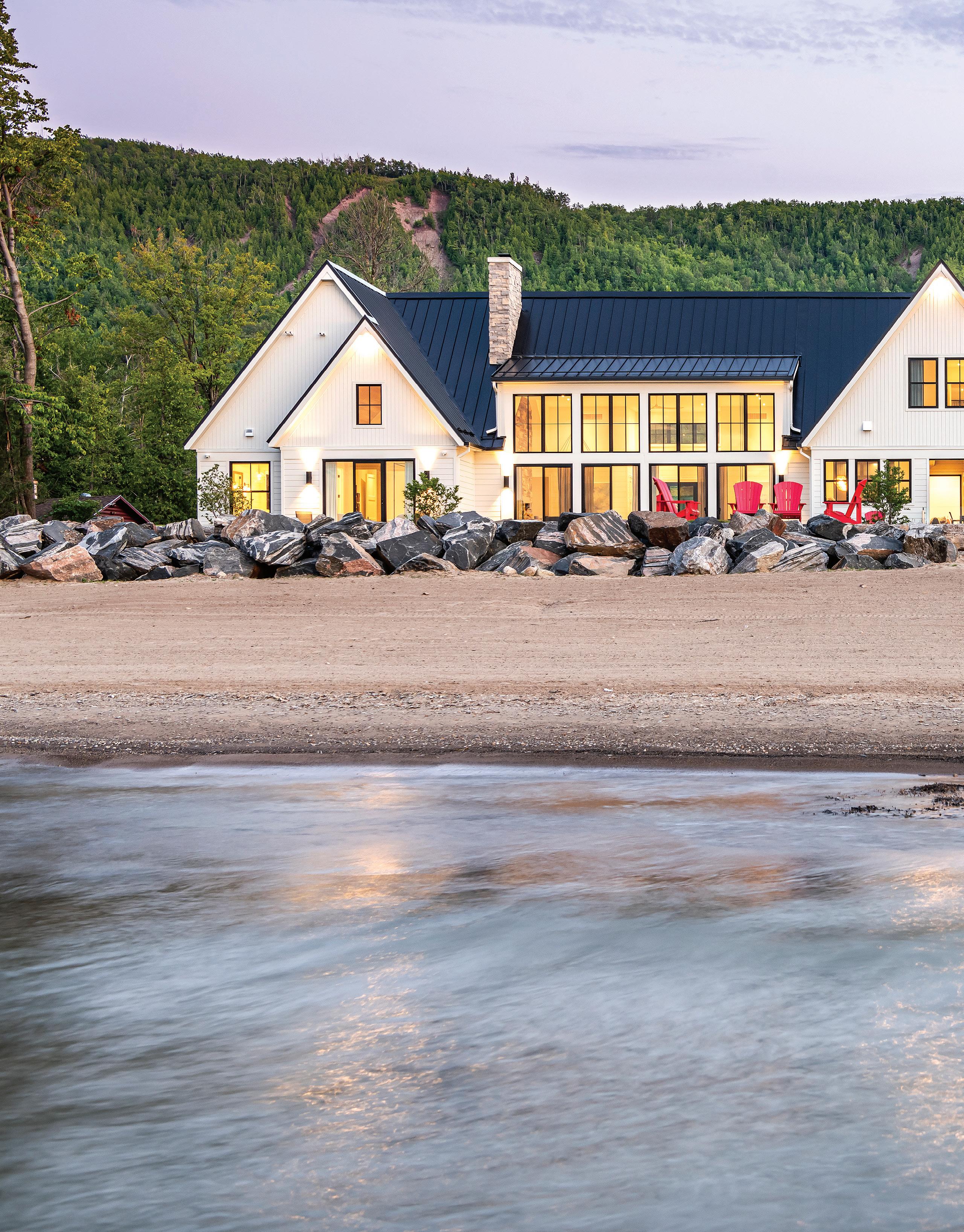
Family is everything for a retired Toronto couple who’ve been coming up the Escarpment for nearly four decades.
by Marc Huminilowycz / photography by Clay Dolan
It all began in 1987 when the couple bought a weekend retreat in Cranberry Village. Ten years later, looking for a larger home in which to spend more time throughout the year, they purchased a condo in Dockside, then later a chalet at Alpine Springs—the development at the base of Alpine Ski Club.
“Our children were getting older, having their own kids, and moving away, and we thought it would be nice to have a place where they could all come back,” says the couple. “Alpine Springs was not big enough for what we desired, so we started looking for another place that would meet our needs.”
As luck would have it, a vacant property with 166 ft. of
Georgian Bay shoreline near Thornbury became available in 2019. The couple jumped at the opportunity to build a family retreat large enough to accommodate their growing family, which then included their three children, their spouses, and six grandchildren.

“We were looking for waterfront to make it a year-round retreat and the site matched all of our criteria; close to Alpine Ski Club, Thornbury, Collingwood, friends, hiking and biking. And, it was on a small, private street that we had not even heard about!”, say the homeowners, who chose architectural designer Bradley (Brad) Abbott to help them realize their dream.
The couple showed Abbott pictures of what they had in mind, including high ceilings, lake views and lots of indoor/
Clear View Electric Ltd has developed a reputation in the custom home and renovation market in Simcoe & Grey Counties. Whether we are involved in custom homes, extensive renovations, or providing maintenance or upgrades to homes or businesses, each is an important task for Clear View Electric Ltd. Each member of our team is dedicated to providing safe and professional services to ensure the beauty and function of your home or business meet the highest possible standards.

705.627.8103
clearviewelectric.ca

david@dmch.ca

outdoor living space. Their must-have list also included a master bedroom on the main floor, numerous bedrooms with ensuite bathrooms and a separate family room where the grandkids could play, watch television and hang out with friends. Construction of the couple’s 6,500 sq. ft. dream home began in December of 2019.
Stepping into the main entrance of the modern beach house, guests immediately enter a spectacular great room/ gathering place with a panoramic, unobstructed view of Georgian Bay. A long hallway with expansive windows that flood the space with natural light, spans the full width of the home. The master bedroom suite and office are at one end, and the family quarters are at the other. “The 126 ft. hallway is the spine of the house that separates the water side from the front yard side, and all functional rooms are arranged along it,” observes Brad Abbott. “Because it’s so long, we felt that we should provide matching full-height and full-width windows at each end, so the hallway never seems to end. Instead of a blank wall, one looks outside to the trees. The homeowners love art, and the side walls of the hall serve as a gallery for their many interesting pieces.”
True to the home’s beach house vibe, the interior has a breezy and airy feel, with white shiplap walls, lightcoloured engineered hardwood floors, ceiling accents, and strategically curated artwork. “We worked with our interior designer Susan Wayne of Wayne Godfrey Designs, and Butter Gallery in Collingwood to choose pieces that are soft and understated,” says the homeowner. Two diptych paintings on either side of the main entrance face the great room—painted by Gabriella Collier, one of the many talented artists represented at Butter Gallery.
The couple added their own personal touches to the décor throughout the home. In a corner of the office stands a massive wooden furniture piece originally from their parents’ cottage. An unusual two-frame painting by Toronto artist Erin Rothstein, depicting red wine and bread hangs

True to the home’s beach house vibe, the interior has an airy feel, with white shiplap walls, light-coloured engineered hardwood floors, ceiling accents and strategically curated artwork.

on a wall off the kitchen, beside a sliding exterior glass door. In the stairway leading to the grandchildren’s bedrooms is a playful metal sculpture of runners by Israeli artist David Gerstein (several members of the family are recreational runners).
The spectacular great room is the heart of the home—with living area, kitchen, dining room, and a massive, wood burning stone hearth—it’s perfect for warming up on chilly spring days. A cozy Muskoka room features automatic retractable screens on the lake side, complete with a heated floor, functional furniture, a fireplace, and even a television. Beyond this is an outdoor kitchen,
hot tub, firepit, a pool with granite slab deck and, of course, the sandy beach – all “catalysts for family gatherings” according to Brad Abbott. With the understanding that the Georgian Bay shoreline is known to fluctuate (and the water is shallow and often cold), the homeowners incorporated a pool into their landscaping plan. This well-loved feature extends their swimming season, which often begins in late spring.

Just inside is a mudroom, bathroom and family room dedicated to the grandchildren and upstairs, they have their own bedrooms. “The girls are on the lake side, the boys across

The couple’s home can best be described as a modern beach house categorized by simple gable forms, steep roofs, white wood siding, minimal eaves and over-sized windows and doors.



the hall on the mountain view side,” say the homeowners, who helped design the rooms to sleep six in each through a clever combination of two queen-size beds on the floor and ladders up to two twin beds.


According to Brad Abbott, the couple’s home can best be described as “a modern beach house categorized by simple gable forms, steep roofs, white wood siding, minimal eaves and oversized windows and doors.” With this in mind, local builder Dave McCombe of DMC Homes in Collingwood was tasked with bringing the project to life.
“The first challenge was protecting the home from the water,” says McCombe. “The property is on what has been classified as
a ‘dynamic beach’, meaning that the levels are always changing because of storms continually bringing sand in and out.” This necessitated two preliminary strategies; building up the site and reinforcing with large rocks; and foregoing a basement in favour of a five-inch concrete slab-on-grade.
The concrete slab allowed for heated floors, which keeps feet toasty indoors and melts snow on the entrance porches and patio during the colder months. A hydronic heating system, including an array of pipes embedded in the concrete (both inside and out), carries hot water to heat the floors. In the absence of a basement, two mechanical rooms are strategically tucked away.
“To protect the home from extreme weather, we installed
“Our children were getting older, having their own kids, and moving away, and we thought it would be nice to have a place where they could all come back.”








a ‘standing seam’, 26 gage steel roof that’s more durable than the standard steel roof,” says Dave McCombe. “And the outside of the house is clad in long-lasting pre-finished bevel and channel Cape Cod wood siding. Inside the home, building materials such as MDF shiplap, solid core doors, and limestone fireplace were chosen not only for their visual appeal, but also for their durability, and with the client’s budget in mind.”
An abundance of glass was required to maximize the spectacular waterfront views—the builder and the homeowners looked for a window and door product that would offer superior protection and insulation from extreme weather, as well as strong visual appeal. Marvin Canada, a company with origins as a family business in Minnesota in 1912 and a 36-year history in Canada, was chosen for the project. “For this home, we used
four main types of window and door products; double-hung windows, operating and fixed casement windows; sliding patio doors; and swinging full glass doors,” says Jim Thring, Ontario Regional Sales Manager at Marvin Canada. “Up to 90 percent of the installation was our ‘Elevate’ product line, which is 100 percent fibreglass on the outside and factory-finished Ponderosa pine on the inside. This combination offers the homeowner superior insulation and zero movement, which means that it doesn’t react to hot, cold or moisture.”

Thring explains that the glass in the windows and doors is double-pane “Low E” (emissivity), which helps with cooling and heat gain. The outside fibreglass frames are virtually maintenancefree because the material is extruded with a colour acrylic resin ‘cap’ on the surface. On the inside, factory painting of the wood offers








“Because the property has so much lake frontage, we were able to stretch the house across its full width. This allowed us to place the grandparents in their own quarters at one end of the house and their children and grandchildren at the other.”

a long-lasting smooth finish that blends nicely with interior design elements. If desired, it can easily be refinished in a different colour.
Thanks to a positive collaboration between the homeowners, the designer, and the builder, construction was completed in just one year. “We know that, with any project, the best-laid plans inevitably change,” says builder Dave McCombe. “I really enjoyed my experience working with Brad Abbott and the homeowners on this home. It has a very well-balanced design.” The couple were equally pleased with their choice of architectural designer, builder, and interior designer. “Brad, Dave, and Susan had good chemistry together, and they were responsive throughout the project to our ideas, needs and concerns,” they said.
Brad Abbott summarized the project as follows; “My clients are grandparents with a growing family. For the extended family to enjoy the property when together, they needed space where they could all gather, and space where they could have privacy. Because the property has so much lake frontage, we were able to stretch the house across its full width. This allowed us to place the grandparents in their own quarters at one end of the house and their children and grandchildren at the other.” Comfort, space, conviviality—a home sweet home for the whole family.
Source Guide:
Architectural Designer – Brad Abbott, Abbott Design
Builder – Dave McCombe, DMC Homes

Interior Design – Susan Wayne, Wayne Godfrey Design Inc.
Select Artwork – Butter Gallery, Collingwood
Windows – Marvin Canada
Kitchen and Bathroom Cabinetry – Norcab Kitchen & Millwork Co. Inc.
Window Coverings – Ashtons Blinds, Thornbury
Appliances – MacDonald’s Furniture & Appliances, Meaford
Entertainment & Alarm System – Thornbury Computers, Thornbury
Tile – Stone Tile Canada
Bunk beds, closets and mudroom built-ins – Georgian Granite Works, Wasaga Beach

All our window and door products are made-to-order with premium materials that range from wood, wood-clad to fiberglass. Depending on the age and style of your home, we can customize the design, the finish and the hardware to make sure it reflects your vision.
Whether you’re building your dream home, renovating, or simply looking to replace your windows and doors, we have experts within your region to help you on your design journey.

We’ve provided over a million windows and doors for homes and businesses in Canada over the last 37 years. Our culture is built around innovation, quality products, proven performance, reliability, and extraordinary service. We focus on the individual needs of our customers, and stand behind every product, every step of the way.





With rattan inspired woven panels, accented with a rounded frame (crafted with FSC®-certified teak) this piece is a breezy, minimalist take on the outdoor sofa. Thick rounded-edge cushioning is covered in UV-resistant, water-repellent Olefin.

FARROW ARCARO DESIGN (FAD)
51 HURONTARIO STREET | COLLINGWOOD
These natural Hair on Hide nesting tables with polished nickel frames are the perfect accent to any room. Made with genuine leather, this set of trays with built-in handles are ideal for accessorizing your living room or bedroom.


ASPEN & IVY
322 KING STREET | UNIT 5 BARRIE | 705.721.8585
ASPENANDIVY.CA
“Indian Head Cove” by Margarethe Vanderpas, oil on canvas, 3ft x 2ft

MARGARETHE VANDERPAS STUDIO 24 CHETWYND LANE | LION'S HEAD 519.433.2840 | MARGARETHEVANDERPAS.COM
Join GB Arts for our first plant show: FOLIARTS! Vendors will be selling rare and tropical houseplants, and offering workshops to help keep your plants happy.
THE GEORGIAN BAY SCHOOL OF ARTS 938 2ND AVENUE EAST | OWEN SOUND WWW.GBARTS.CA

Traditional and timeless, this power-loomed rug is crafted of 100% polyester. With a sophisticated colour palette and subtle patina, its beautiful livedin design captures the spirit of an old-world rug.

BAREBRICH

920 2ND AVENUE EAST OWEN SOUND
226.664.2273
BAREBIRCH.CA


Archilog’s collection of firewood holders are inspired by architectural influences. Hand crafted with Canadian steel, they’ll last a lifetime and complement your contemporary home or cottage. Available in black or slate grey powder-coated finishes.

ARCHILOG
519.400.6633 | ELMIRA ARCHILOG.CA
STUDIO 101 ART GALLERY 101 GROSVENOR STREET SOUTH SOUTHAMPTON | 519.797.2052 IG @ STUDIO101ARTGALLERY
“Little Red Roof” by
Afonso. 40" x 40", oil on canvas. BUTTER GALLERY 126 HURONTARIO STREET COLLINGWOOD | 705.444.9228 BUTTERGALLERY.CA
519.371.2963 |

This cushioned cotton and linen chair is the perfect addition to your living or bedroom space.

25.5''W x 34''D x 34.5''H
ARTHUR CASH & CARRY
101 SMITH STREET | ARTHUR 519.848.6320 ARTHURCASHANDCARRY.COM
“Seeing Beyond the Illusion” by Patricia Gray. 15" x 51" frame, acrylic on gallery wood panel. BLACKSPRUCESTUDIO.COM

MERAKI ART | 240 EAST ROAD

LION’S HEAD | 705.475.6248
“Arise” by Mark V. Nadjiwan. 14" x 18", pen and ink on illustration board. THREETREESART.COM
companion—as is this easy-to-carry denim tote from Heating & Plumbing London.


MAGGIE + DIX HOME AND GARDEN 90 SYKES STREET NORTH | MEAFORD MAGGIEANDDIX.COM
This beautiful mahogany entrance door features plank-style charm and openable sidelights—perfect for breezy spring and summer days ahead.

DESBORO DOORS
135830 R.R. #1 CONCESSION 8 | DESBORO 519.363.5635 | DESBORODOORS.COM
With its bold black colour and sleek design, the Eglo Walker Hill wall light will brighten up your exterior while adding great curb appeal and modern aesthetic.
GEORGIAN DESIGN CENTRE 84 HIGH STREET | COLLINGWOOD 705.444.2100 | GEORGIANDESIGNCENTRE.CA







From the moment you bring it home, the BX23S is ready to go to work—loading, mowing,

LOFT GALLERY | 18 BRUCE STREET | THORNBURY 647.296.9797 | LOFTGALLERYART.COM

Made from recycled plastic, this Adirondack chair will add character to any outdoor space. Pair it with a fire pit constructed from upcycled propane tanks to finish the look.


THE RUSTY STAR
408065 GREY ROAD 4 MAXWELL | 519.922.2010
THERUSTYSTAR.CA
MacAusland woolen blankets have been made in Prince Edward Island for six generations. Made with 100% soft virgin wool, the blankets come in a variety of colours and are an essential for indoors or out by the fire.

LOVED YOU MADLY
16 BRUCE STREET | THORNBURY 226.665.3533
LOVEDYOUMADLY @ GMAIL.COM
PETER DUŠEK GALLERY
151 MILL STREET
CREEMORE | 519.217.7770

PETERDUSEK.COM
This
MACDONALD'S FURNITURE & APPLIANCES
206518 HIGHWAY 26 EAST | MEAFORD | 519.538.1620
MACDONALDSFURNITURE.COM
“Spirit of the Forest” by Lorne McDermott, 48" x 30", oil on canvas. Scandinavian style chair with deep tufting and solid wood frame from Palliser, is perfect for both relaxing with a book or entertaining guests.





















Roberto Coin 18 karat yellow gold necklace with diamonds, gold hoops with diamonds, paperclip necklace, and dia bangle.
Photographed on-location at Morland Place, Owen Sound—special thanks to Barry More Hair and Makeup by Katie Ballantyne, photography by Clay Dolan

Shelby is a local real estate broker who lives in the Town of the Blue Mountains with her fiancé Taylor and their French bulldog, Dan. She loves sharing her enthusiasm for life on the Escarpment with her clients.
“Helping you love where you live, your home girl Shelby.”

Bronte moved to Collingwood two years ago and is the Community and Events Manager at Side Launch Brewing Co. “I love connecting with the community and being involved in the gorgeous town of Collingwood. I have two dogs that keep me very busy in the outdoors and all the trails Georgian Bay has to offer!”

Kristen is a wife and mother to two amazing boys. “I love that this area provides four-seasons of exploration. I have a passion for working with seniors within Grey County Long Term Care and I feel privileged to be amongst a population of individuals who are the foundation of our community. I truly enjoy the wisdom of their stories and the relationships built.”

Clothing and footwear from Red Devil Sports, Blue Mountain Village.
SHELBY ELSTONE


Clothing and footwear from Dawe and Co., Downtown Collingwood. KRISTEN




of the full extent of their responsibilities and liabilities as they relate to the Act.
Spencer Safety Solutions is a health and safety consulting firm, helping small businesses protect their workers and themselves from additional liability. Owner Janice Campbell has worked in safety consulting for over 15 years—she established the business in late 2021 after noticing a gap in the market. “We are the only safety consulting firm in the Grey-Bruce area,” says Janice. “We are a purpose-built company driven to help small business owners understand, navigate and comply with the Ontario Occupational Health and Safety Act.”

Many businesses may not be aware
Spencer Safety Solutions does all the heavy lifting to make sure your business meets or exceeds its responsibilities to ensure a safe workplace to help retain valued employees.
Led by Janice, who holds a degree in Human Resources Management and Occupational Health and Safety, Spencer Safety Solutions helps businesses proactively inspect, understand and create a workplace that is both compliant and effective. “Our experience working on some of Ontario’s largest construction projects will give you insights into best practices that suit your needs.”
Spencer Safety Solutions offers support in developing next-level programs
weddings and special events.
that make your company and culture a desirable place to work for and work with. They believe in providing honest and reliable information to clients. “Our focus is small businesses who do not have time/ knowledge/resources to manage their safety program on their own. We also assist construction companies who need regular inspections of their worksites.”
Whether a company is being proactive in helping to protect their workers or reactive after receiving orders from Ministry of Labour, Immigration, Training and Skills Development (MLITSD) or after an injury, Spencer Safety Solutions is here to help, without judgement.
201-1717 2nd Ave E, Owen Sound spencersafetysolutions.ca
Lighthouse Group is a premier residential and commercial cleaning company, servicing Southern Georgian Bay and surrounding areas since 2010. Then, in 2021 owners Behn and Hillary Mitchell expanded the business to include more cleaning services as well professional lighting and custom window coverings, creating sister companies: Lights at Blue and Shades at Blue.
Cleaning services include residential and Airbnb customer care, windows and screens, commercial cleaning and power washing. Shades at Blue offers an uncompromising selection of products with priced for value—from budget blinds and accessories, to custom-fitted shades and shutters to compliment the style of your home. Lights at Blue provides design, sales, installation, removal and storage of commercial grade lighting for seasonal holidays, backyards, patios,
“We are driven by long term goals and a determination to provide the best services in Collingwood and the surrounding areas,” says Hillary. “We are a forward-looking company that provides our team with health benefits and pays above the living wage for our area. We strongly believe that having a happy and healthy team leads to happy clients. We believe in treating our team and our clients with the utmost respect and we pride ourselves on providing reliable and affordable services. We also use the best professional equipment for each service! For example, with window cleaning we use a Pure Water system which employs a four-stage filtration system to deliver pure water to the windows with waterfed poles giving you a streak free and chemical free clean and with Lights at Blue we offer commercial grade lighting which lasts longer and shines brighter than store bought lights.
In 2022 Hillary and Behn proudly opened a Lights at Blue and Shades at Blue showroom within Chatterson’s
Home Furniture in Collingwood. Members of the Collingwood and Blue Mountain Chambers of Commerce, the enterprising couple are also heavily involved in community initiatives and supporters to local charities. “We hire students and sponsor events such as Collingwood Pride, Coldest Night of the Year, as well as various sports teams. “Collingwood and the surrounding areas are a beautiful place to live and raise a family! We have four children and this is a fantastic place for them to grow up. The Southern Georgian Bay area is also growing significantly and there is a great need for reliable and high-quality cleaning services. We also found our clients were looking for window covering and exterior lighting services which was how we decided to expand and offer these services as well.”
101 Pretty River Parkway, Unit 7, Collingwood
lighthousegroup.ca / shadesatblue.com / lightsatblue.com







Located in the heart of Sauble Beach, Crust & Crackle uses traditional baking practices, ensuring that every loaf is made with skill, attention to detail and lots of love. Owners Katy and Matt Stroud established the business in October 2020. “Right smack dab in the middle of the pandemic,” says Katy. “This just started as a hobby selling a few loaves to neighbours and some Sauble locals. It quickly grew from 20 loaves a week to 150 loaves a week to suddenly 300-500 loaves a week. In such a short period of time, two-and-a-half years to be precise, we have transformed our home kitchen into a full-on bread bakery, upgrading all of our home appliances to commercial equipment in order to keep up with the demand.”

After completing a Culinary Management program at Georgian College, Katy achieved Red Seal stats, which opened the door for her to start teaching pastry at Georgian College. “While starting my teaching career I also started a Private Chef business called The Denim Chef. It
was only natural for me to roll into the bread world. It wasn’t until our son was diagnosed with very serious food allergies that I started to take baking everything from scratch seriously. After a few years of baking for ourselves I was curious to see if anyone would be interested in buying my bread.”
In the summer of 2022 Matt, who is a fully licensed electrician quit his job to help with the family business. “My husband is my baker in training. Leaving his days of crawling in attics and crawl spaces behind, and instead to dig his hands into the world of flour. From deliveries, to shaping loaves and baking he has fully immersed himself into my bread world.”
Using local ingredients and modernized flavours, Crust & Crackle has recreated the basic loaf of bread, and as Katy says, “turned it into your next craving.” Because they are not a brick-and-mortar bakery, they offer a flexible solution for our customers to pick up their orders. “Mainly we sell directly to our customers through our online ordering system. They can then choose one of our pickup locations throughout Grey and Bruce County. Over the past two years we have partnered with eight local complimentary businesses
to offer convenient pick-up points for our customers. These locations include Southampton Olive Oil Store, Port Elgin Cheese Haus, Tara General Store, Desboro General Store, Heat’n Eat Meal Co, Birgit’s Bakery, Your Local Meat Shop and The Dandy Lion. Some of these locations plus others stock our bread 1 – 2 times a week for the customer who would rather walk in and purchase a loaf. These locations are Port Elgin Cheese Haus, Tara General Store, Desboro General Store and Sugar Dust Baking. We are excited to continue expanding throughout Grey & Bruce with additional locations.”
“It is so important to us that we know what ingredients go into our food and who has produced it. We are huge advocates for supporting local farmers and producers— most of our diet is supplied from our local farms. As a family that suffers from serious food allergies, we wanted to be able to sell a product that suits most people’s diets. We believe that we have done that. Good quality, simple recipes, and local food should adorn every pantry and fridge. Go ahead and put a little local into your life.”
Located on Highway 6&10 in Chatsworth, 6 & 10 Euro Market is a small family owned business that offers on-site homestyle cooking with a vast selection of top-selling European specialty meats.

Owners Olenka and Oleg Mouzitchka moved to the area in 2022, and decided it needed a European twist. “Previously we ran a small weekend market, which is how we first became involved in the food industry,”
says Olenka. “However, after moving and having the opportunity to stay involved and continue to share eastern European foods and products with our community we couldn’t pass on it. We believe in serving our customers as we serve our family and emphasize creating a culture of inclusiveness and belonging where anyone is welcome.”
Specializing in gourmet coffee and sandwiches, 6 & 10 Euro Market also offers an assortment of ready-made foods like homestyle cabbage rolls, perogies, as well as kielbasa, smoked meats and fish. They also stock a variety of pickled and canned
preserves jams and caviar and have an impressive selection of European groceries, cheese, bread, baked goods, sweets, candy and ice cream.
“We are a small business,” says Olenka. “Our store is an extension of our culture that we would love to share with the community through our food and other products. We welcome everyone to come whether they’re interested in trying new foods for the first time or not. A large part of culture is integrated into food and we would love to share with anyone who’s interested!”
317080 Hwy 6 & 10, Chatsworth



 Michael Morris Senior Mortgage Specialist RBC Royal Bank of Canada
Michael Morris Senior Mortgage Specialist RBC Royal Bank of Canada
Attention homeowners, buyers, and real estate enthusiasts: the real estate market in Southern Georgian Bay has experienced a bit of a shake-up. The oncehot market, fueled by low interest rates, has cooled off in the last 12 months with home prices dropping due to interest rate increases. It’s a stark contrast to the frenzy we saw during the pandemic, leaving many buyers and homeowners with new uncertainties. But fear not, with change comes opportunity. I’ll explore current mortgage trends and offer advice on how you can use that to your advantage while navigating the Southern Georgian Bay housing market.

Advice is especially crucial as homeowners look for ways to save in a rising rate environment.



Since March 2nd 2022, we’ve seen the Bank of Canada increase the overnight target several times, which directly impacts borrowers on variable rate mortgage and adjustable rate mortgages. Let’s break down the two types:
Adjustable-Rate Mortgage: your payment adjusts as the mortgage rate goes up or down. Over the last 12 months, borrowers in this type of mortgage option would have felt instant impact of rate changes as their payments would have increased immediately with every Bank of Canada rate hike keeping the amortization in line.
Variable Rate Mortgage: your payment amount stays fixed and if your interest rate goes down, then more of the payment will be allocated towards principle. If the rates increase, more will be allocated towards interest. The term “Trigger Rate” was often used by mortgage professionals during the late summer and early fall of 2022. What’s that you might ask? Well, it’s when you’re in a variable rate mortgage with a fixed payment option and the interest rates have increased to a point where your fixed payment no longer covers the minimum interest portion, and the lender is required to increase the fixed payment to at least cover the interest portion. Although the payments stay lower in comparison to an adjustable-rate mortgage; the drawback is that the amortization will increase since there’s no principle being paid down and upon maturity, the mortgage will need to be brought back to within standard amortization guidelines.
These higher rates and payments translate into the primary question and concern that I now receive daily from clients; what mortgage term should I go in; how do I increase cashflow; what’s my affordability? Regardless of whether you’re buying a home, or refinance/renewing, we’re seeing that most clients are renewing or buying in a shortterm fixed rate typically anywhere from one to three years with hopes and expectations of rates eventually coming down.
Clients with lower rate mortgages that are maturing may find their budget can’t sustain the increased payment amounts—but there are ways to improve cashflow. This could involve extending the amortization to a maximum of 30 years (for eligible mortgage products), changing from an accelerated payment to a standard payment frequency, or consolidating higher interest debt. With the significant growth in Southern Georgian Bay housing prices, there is likely equity built up in the home that would give a borrower flexibility to take advantage of these options.
For homebuyers, increased mortgage rates also increase the qualifying rate or “stress test” which could potentially decrease their purchasing power. On the other hand, the increase has led to a decrease in the price of homes, which for a buyer, could mean lower closing costs (specifically on land transfer taxes), and a lesser down payment than they would have needed a year ago. What we’ve also seen more of from a homebuyer’s perspective, is the ability to put a financing condition (amongst other conditions) on an offer, which was certainly not the case during peak pandemic times.
When searching for a home to purchase, whether investment property, primary residence, cottage/vacation home, it’s imperative to go through the mortgage pre-approval process in advance before you start your search. A pre-approval will involve your mortgage professional going
through credit information, collection of income documents, verifying source of down payment and going through a complete review of your finances to ultimately determine your pre-approval amount. In Southern Georgian Bay there is a variety of options. Aside from a freehold, your purchase could also be a home with significant acreage, leased land, threeseason cottages. With different property types, lenders might have different policies that they follow, and by advising your mortgage professional during the preapproval process they can provide advice around this.
Ultimately, the low mortgage rates during the pandemic had a significant impact on the Southern Georgian Bay’s housing market, driving up demand and prices. Many clients—both locally and from urban areas—were able to take advantage of the low rates by purchasing primary homes, second homes, and investment properties as people flocked to area for a more balanced lifestyle. However, with the increased rates and mortgages beginning to mature, clients will need to adjust their expectations, and consider how the higher rates will impact their ability to purchase and impact their personal finances moving forward. It’s important for individuals to stay informed, determine a strategy, and work with both a local real estate representative and a mortgage professional to help navigate the evolving real estate market.
The low mortgage rates during the pandemic had a significant impact on the Southern Georgian Bay’s housing market, driving up demand and prices.
















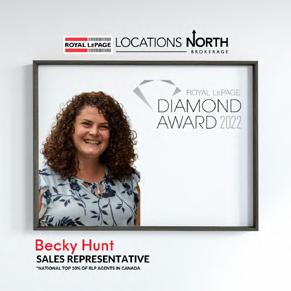















































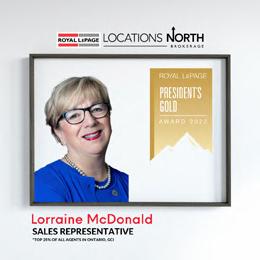

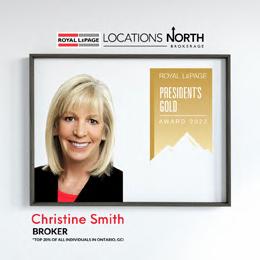





















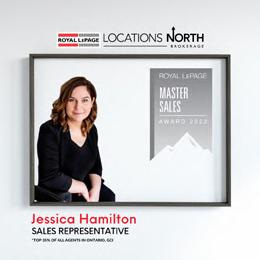




























































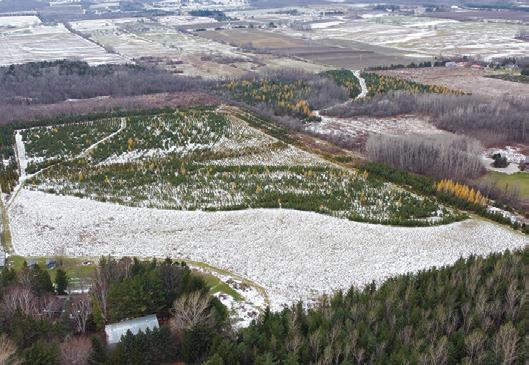


















Tastefully finished, bright 3 bedrooms, 2.5 bathrooms freehold town in a lovely family neighbourhood. Close to schools, a wonderful park/playground right across the street, and downtown. Sit out on your south facing covered porch and enjoy the gorgeous perennial garden and open view to the park. Fabulous walking & biking trails close by. This home features a beautiful kitchen with many upgrades. Open concept with 9’ ceilings. Spacious entrance, powder room and access to oversize garage. 2nd floor has primary bedroom with walk in & beautiful bathroom with gorgeous glass shower. Two more bedrooms, main bath and laundry closet. Large basement for future development.





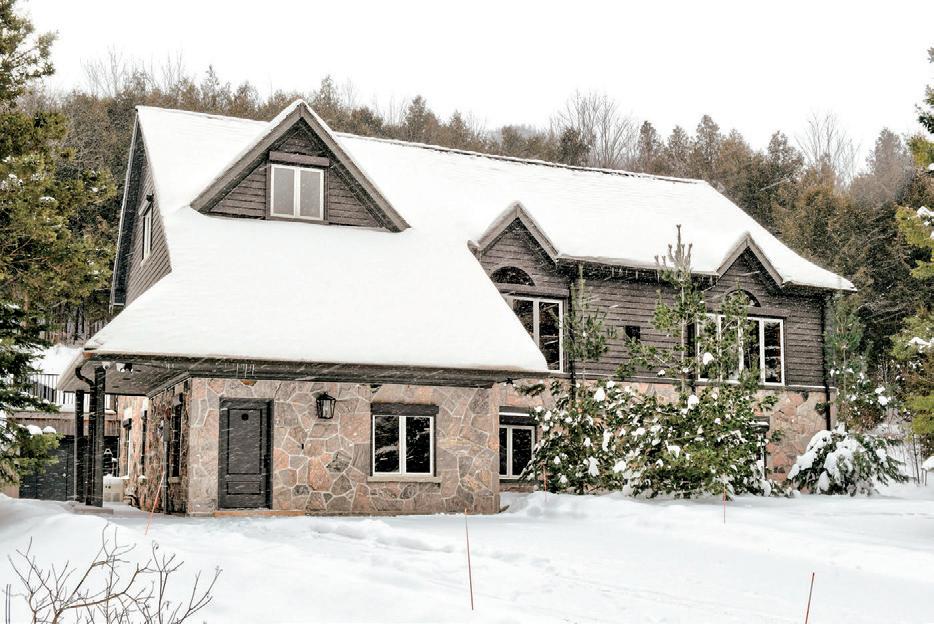






“I have a friend who lives on a large piece of property and while out for a walk one day, I came across what I suspected was a fox den. I set up a couple of trail cams and sure enough, the cameras captured eight beautiful little kits as they emerged from the den. Throughout the next few months I was able to witness the daily activities and capture multiple images and of these beautiful creatures.”

“My career in photography was anything but planned—it originally started out as a therapeutic medium after a near fatal incident following the birth of my last child which left me in a coma. In the years following, I endured multiple surgeries and a long recovery. I took up photography for an outlet to help with my healing and fell in love with the artform in the process. I decided to pursue photography as a career, and while the circumstances that lead me there were traumatic, I believe there was a reason for these challenges and personal trials in my life. I look forward to growing as a photographer—there’s always something new to learn.”
Christine Hess christinehess.comFans of ‘Yellowstone’ will know the length to which the Dutton family will go to preserve and protect their land. Especially Beth. It is that passion for the Georgian Bay area’s farms and rural acreages that make us the clear choice when buying or selling precious rural properties. As local landowners, we understand the intricacies of country properties, and we also understand the emotional attachment – especially wh since 1977 . , our local knowledge combined with our international network is your advantage. Plus, we like any excuse



Learn more at mcgregorhahnegroup.evrealestate.com


Direct +226 974-2144
mcgregorhahnegroup@evrealestate.com

